Family Lamiaceae
Species: Prunella vulgaris
Origin: Eurasia
Plant: Low-growing perennial
Height: 10 cm groundcover
Soil: Rich, cool, moist soil
Exposure: Light shade
Propagation: Cuttings, division
Uses: Culinary, medicinal
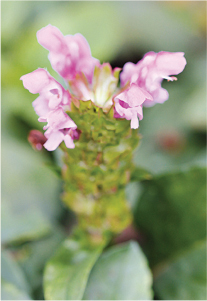
Prunella
Self heal
Family Lamiaceae
Species: Prunella vulgaris
Origin: Eurasia
Plant: Low-growing perennial
Height: 10 cm groundcover
Soil: Rich, cool, moist soil
Exposure: Light shade
Propagation: Cuttings, division
Uses: Culinary, medicinal

An old and loved little herb, prunella had a place in herb gardens through the centuries for its remarkable antiseptic and anti-inflammatory properties. The name prunella comes from the German name for the herb, ‘brunella’, used to treat ‘die Braüne’ or a sore throat. Its ancient English name was ‘woundwort’, as it was used in medieval times as a wound herb, as well as for throat problems.
Prunella came to be overshadowed by more spectacular herbs, but it is being recognised internationally as a herb for the future, especially for its exceptional ability to clear mouth and throat infections, and to lower blood pressure. I have used and experimented with it, and have found it to be a gentle yet thorough healer.
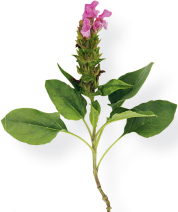
CULTIVATION
Rich, well-dug, well-composted soil that retains moisture is vital as prunella comes from the cool, moist meadows of Europe and Asia. Give it a long, slow watering 2–3 times a week. In our dry African heat, prunella does far better in partial or light shade, although it has adapted to harsh weather conditions. It is an undemanding groundcover, neat and attractive, and forms a thick, evergreen mat. It flowers throughout the year, forming little spikes of mauvy-pink, ‘labiatae’-type flowers that stand above the carpet of soft leaves, and attract bees and butterflies. I have also seen it grown as a pot plant on a shady verandah for quick pickings.
PROPAGATION
Use a sharp spade and slice off the edge of the clump, as it has many little rooted tufts of leaves. Immediately press the tuft into a compost-filled bag of moist and friable mixture. Keep shaded and moist until it establishes well. Then plant it out into richly composted soil in partial shade.
HARVESTING AND PROCESSING
Use prunella fresh. Flowers, leaves and sprigs can be picked continuously for culinary use and medicinal teas.
COMPANION PLANTING
In Europe, prunella is planted in wildflower meadows, and I tried it one year in a newly cleared field with ‘meadow herbs’ like yarrow, cornflowers, red Flanders poppies and chamomile. It thrived under the shade of taller herbs and helped to keep the weeds down.
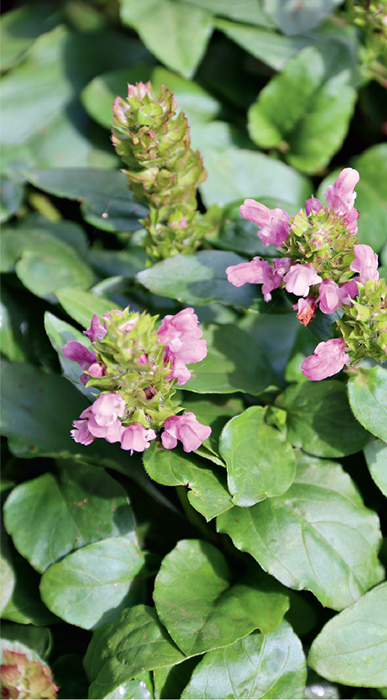
CULINARY USES
The Chinese have used prunella since about 200 BC and still cook with it as a stir-fry, often combined with chrysanthemum petals (see p. 70). Fresh prunella leaves add a pleasant, although slightly bitter taste to salads, but with a squeeze of lemon juice it soon becomes a favourite. The leaves can also be added to soups.
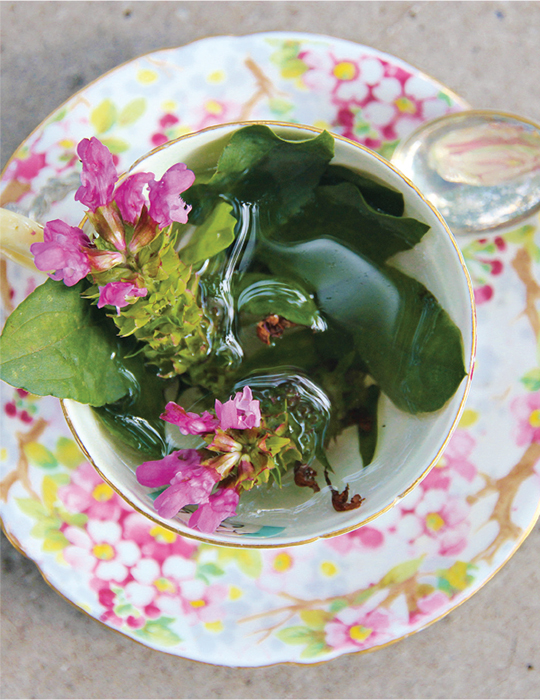
Prunella tea
MEDICINAL USES
Prunella was listed as one of the most reliable herbs in the pharmacopoeias for excessive menstrual bleeding, haemorrhaging, sore throat (it was known as the ‘quinsy herb’), swollen tonsils, mumps, fevers and headaches; it was also used to stimulate the gallbladder and ease high blood pressure. It was taken in the form of a tea for all these ailments.
TO MAKE THE TEA: Pour a cup of boiling water over ¼ cup fresh leaves and flowering heads. Leave the tea to stand for five minutes, stir well, then strain and sip slowly. In the case of excessive menstrual bleeding, ¼ cup chrysanthemum petals can be added to the tea and taken twice daily throughout the menstrual cycle, with comforting results.
Prunella is also the first herb listed in the treatment of certain modern-day problems, for example mouth and gum infections, hyperactivity in children, liver overload, and haemorrhoids. It has excellent diuretic properties, which help to lower high blood pressure (take a cup of prunella tea once or twice daily as advised by your doctor). This same tea, used as a gargle and mouthwash at least 4–6 times through the day, is a valuable treatment for sore throat and gum and mouth ulcers, infections and bleeding. However, seek medical attention for gum disease as it can be linked to health problems in other parts of the body.
New uses for prunella tea include diarrhoea, painful breasts during the menstrual cycle, and internal bleeding from peptic and duodenal ulcers. Warm prunella tea swabs can be held in place over throbbing wounds (reapply as soon as the warmth goes), and the cooled tea is very comforting for conjunctivitis, used on clean cotton-wool pads. The cooled tea has been used for centuries as a wash, lotion or poultice over bruises, sprains, slow-healing sores, mild burns and haemorrhoids. The herb can also be used to make an excellent healing cream for minor grazes, rashes, stings and bruises. Prunella is worth its weight in gold!
Purslane
Family Portulacaceae
Species: Portulaca oleracea
Origin: Eurasia, cosmopolitan
Plant: Annual, fleshy trailing weed
Height: Ground-hugging
Soil: Any soil
Exposure: Takes full sun and light shade
Propagation: Seeds
Uses: Culinary, medicinal
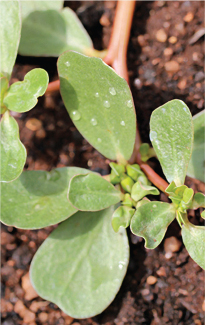
Purslane is listed among the 10 worst weeds in the world, along with blackjack (p. 52), but I am working to get them both removed from the list because of their incredible medicinal properties! How often have we pulled purslane out of our vegetable gardens, frustrated at its presence and unaware of the rewards we could reap? Today I nurture it and transplant the seedlings.
Purslane was known to the ancient Egyptians as a medicine for dysentery, for lowering high blood pressure, for haemorrhoids and externally for boils. It was grown as a healing food in India for thousands of years, and used in ancient Coptic medicine for swollen joints and feet, eye infections, inflammations, and as a skin lotion. More recently it has been cherished by the Italians and French, particularly.
France is the major producer of purslane as a salad ingredient and vegetable, and the French also turn it into tasty pickles. Dried purslane is popular for teas in winter and is added to soups and stews for its extraordinary medicinal properties. France also cultivates purslane for the pharmaceutical industry and research.
CULTIVATION
Dig over a furrow of richly composted soil in full sun, flood it with water and transplant purslane seedlings, usually just under thumb length, spacing them 15 cm apart. The plant grows quickly and, with a flooding of water 2–3 times a week, you will be able to pick it constantly for salads and soups. It is a tough survivor plant.
PROPAGATION
The seeds are prolific. Dig up young seedlings with a trowel and transplant them.
HARVESTING AND PROCESSING
Pick fresh as needed for culinary use. I often harvest mature flowering plants and use them as a mulch to grow more seedlings. Purslane can be dried for use during winter.

Purslane, added to salad, can help to lower high blood pressure.
CULINARY USES
The reddish stems with their succulent, spoon-shaped leaves can be added to salads as neat little clusters. A squeeze of lemon juice and a dusting of paprika make it perfect with other salad ingredients. Try it in soups, stews, stir-fries and relishes. Chinese visitors tell me they cook it in noodle soup, with a tasty chicken stock.
SERVES 4
FILLS 4–6 JARS

MEDICINAL USES
Research has shown that purslane is one of the few plants with an incredibly rich omega-3 fatty acid content (the other is chia, p. 66). This makes it very important for treating pain, preventing heart attacks and heart disease, for strengthening the immune system, and for treating dysentery, enteritis, mastitis, haemorrhoids, appendicitis and high fever. It also clears toxins and acts as a diuretic.
A major benefit of fresh raw purslane is that it is effective against bacterial infections, which is proving valuable in the face of our over-use of antibiotics. Purslane sprigs in a daily green salad can also help to lower high blood pressure (no salt should be added). Externally, purslane juice and poultices are used to treat eczema, to bring boils to a head, and to treat insect bites and bee stings.
WARNING: Do not give purslane to pregnant women or to anyone suffering from digestive ailments. Like all herbs it needs to be used under a doctor’s guidance.
Red brinjal
Aubergine / eggplant
Family Solanaceae
Species: Solanum melongena var. ‘Ruby Congo’
Origin: Congo
Plant: Short-lived perennial
Height: Up to 80 cm
Soil: Rich, well-dug soil
Exposure: Full sun, light shade
Propagation: Seed
Uses: Culinary, medicinal
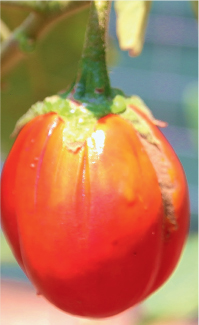
Ethiopia and the Congo were the first to grow red brinjals, although it is believed that all bringals stemmed from a bitter, spiny variety found wild in India. China, too, had brinjals and first recorded the plant as a medicine from 500 BC. Eventually, brinjals were sold on the great trade routes, and the Arabs introduced them to the Mediterranean. Today there are many shapes and colours, from pure white to dark-skinned purple beauties.
CULTIVATION
Plant out in rows in a deeply dug, richly composted bed, in full sun or light shade, and water thoroughly. Thereafter give the row a long, slow watering three times a week. The plant is much loved by grasshoppers, which make holes in the leaves; regularly use a strong khakibos spray to repel them.
PROPAGATION
Sow the seeds in spring, in trays filled with moist soil mixed with compost, and water daily. Once the seedlings are big enough to handle, prick out and plant in bags filled with rich, moist compost and topsoil. Do not allow them to dry out. When they are sturdy, place the bags in the sun for an increasing time each day, until they can take sun all day and are ready to be planted out permanently.

Red brinjal ripened to dryness and collected for seed
HARVESTING AND PROCESSING
For culinary use, pick the young, green fruits when they just begin to show a touch of red (they turn brilliant red very quickly, so check your row daily). Once the fruits are bright red they are full of seeds and almost unpalatable. To collect seed, allow fruits to ripen to dryness on the plant; then clip them off, split the fruit open on brown paper and let the seeds dry in the shade. When thoroughly dry, store the seeds in a bottle with a good screw-top lid, label and date.
CULINARY USES
Congolese visitors have told me to use the red brinjal when it is still green; it should be cut into thin slices and fried in oil on both sides, with salt and lemon juice. Another popular method is to dip the slices into batter and fry them in oil with salt, as a meat substitute. Slightly riper fruits are used together with onions and tomatoes in delicious chicken, beef or goat stews, and on holidays and celebrations, big platters of ‘pancakes’ are made using slices of still-green brinjal. The Congolese also make relishes with it, and sweet-and-sour sauces.
SERVES 4–6
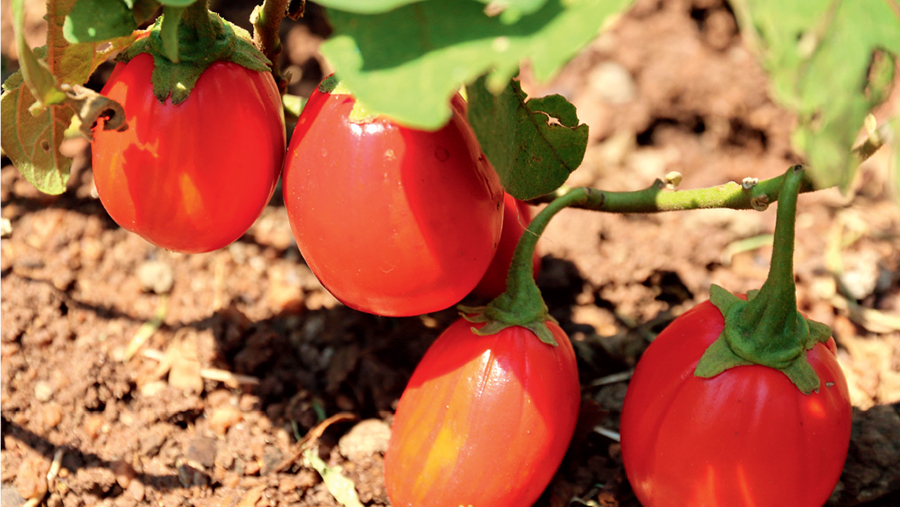
MEDICINAL USES
Red brinjal is used to make a tonic medicinal soup given for bronchitis, flu, colds, coughs, chesty phlegm and breathlessness. It is made with a number of other ‘super’ herbs and vegetables, including fresh melokhia leaves (see p. 144), fresh coriander leaves, onions or welsh onions (see p. 212), and kale leaves.
This basic recipe is from Congolese visitors who say the soup is ‘the best of medicines’, especially for old people and children who do not thrive. Blackjack leaves are often added to soups and stews to build health and resistance.
Interestingly, melokhia with red brinjal is a traditional medicinal dish used in Egypt, the Congo, the Ivory Coast, Democratic Republic of the Congo and northern Zimbabwe as a tonic for the liver and bladder, and to aid convalescence.
The name ‘eggplant’ derived from 18th-century European cultivars, which resembled goose eggs in shape and colour.
Red hibiscus
Family Malvaceae
Species: Hibiscus rosa-sinensis
Origin: Warm, tropical and subtropical regions (Hawaii, Jamaica, South America)
Plant: Shrub or small tree, multistemmed
Height: Up to 5 m
Soil: Rich, deeply dug, neutral soil
Exposure: Full sun
Propagation: Cuttings
Uses: Culinary, medicinal
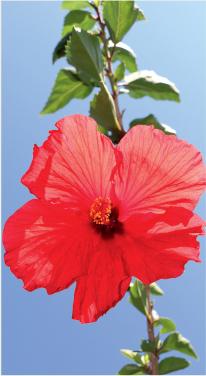
Red hibiscus has been a ceremonial and medicinal plant throughout history. The flowers were used in religious ceremonies and at births, marriages and deaths, and it is recorded medicinally in pharmacopoeias from Hawaii to China. It is said to be one of the plants in the Garden of Eden and the Hanging Gardens of Babylon. Today, brilliant hybridised multicoloured blooms grow in botanical and home gardens worldwide. However, it is only the common red hibiscus, the true rosa-sinensis, that has the vital medicinal properties.
CULTIVATION
Hibiscus needs a deeply dug, compost-filled hole. Flood it with water once a week (more often during a very hot, dry summer). Full sun is an absolute necessity for flower growth. Give each shrub a barrow-load of compost twice yearly.
Although a tropical and subtropical plant, this resilient shrub has adjusted to colder winters; given a protective winter plant fleece and good mulch, it will survive. It lives for a long time and is easy to grow, and thrives with pruning and cutting back. Clipped hibiscus hedges are popular. Left to grow unchecked, hibiscus shrubs reach a height of 4–5 m, with a spread of 3–4 m.
PROPAGATION
Propagation is by cuttings taken in spring and early summer. Press cuttings into moist, sandy soil and keep shaded and protected until well rooted. Plant them into compost-rich bags to establish before planting out permanently in full sun.

HARVESTING AND PROCESSING
Flowers can be picked at any time as they bloom almost throughout the year. In colder areas, dry the flowers for winter use on brown paper in the shade. Turn the flowers daily, then store in glass jars with lids. Use in a tea or lotion the same way fresh flowers are used.
CULINARY USES
Red hibiscus flowers are commonly used as a tonic tea, as a food colouring, in jelly, and in salads. Steamed flowers filled with savoury rice, or fresh flowers filled with chopped cucumber, celery and mayonnaise, remain favourites in many countries. Jellies, jams and cordials made with hibiscus flowers are still served in restaurants worldwide. (Note that Hibiscus rosa-sinensis is different from H. sabdariffa, where the bright red calyx is used).
SERVES 4–6
DRESSING
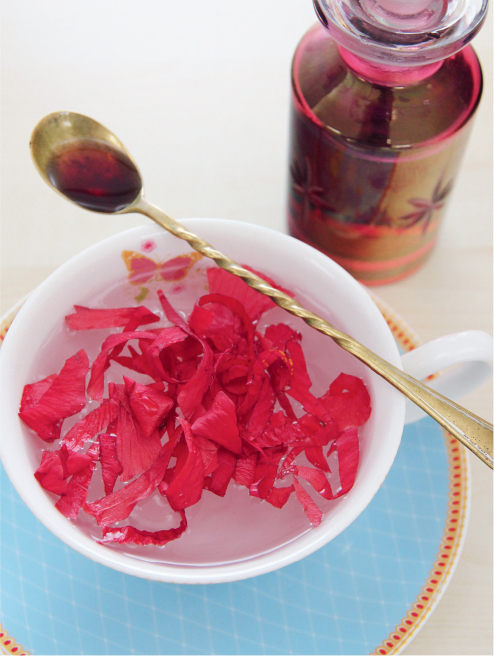
Hibiscus honey cough remedy and hibiscus tea
MEDICINAL USES
Red hibiscus tea is used to ease coughs, colds, hiccoughs, cystitis and painful menstruation; it will also help to lower fevers, relax muscle spasms and abdominal pains, release colic and bloated flatulence, and treat venereal diseases. It should be taken internally, and the cooled tea can also be used as a refreshing wash.
TO MAKE THE TEA: Pour a cup of boiling water over one finely chopped flower (stamens included). Let the tea stand for five minutes. Stir frequently, then strain and sip. Hawaiians used the cooled tea as a spray over sunburned shoulders and as an all-over splash for heat and fever. Hibiscus is known as a cooling herb and the cooled tea can be frozen into ice cubes and sucked, or crushed and sipped in order to relieve hot conditions and heatstroke.

Hibiscus lotion
Sacred basil
Tulsi
Family Lamiaceae
Species: Ocimum sanctum, now Ocimum tenuiflorum
Origin: India, Sri Lanka, Malaysia
Plant: Perennial shrub
Height: Up to 1.5 m
Soil: Unfussy, thrives in compost-rich soil
Exposure: Can take full sun, enjoys light shade
Propagation: Cuttings, seeds
Uses: Culinary, medicinal, insecticidal
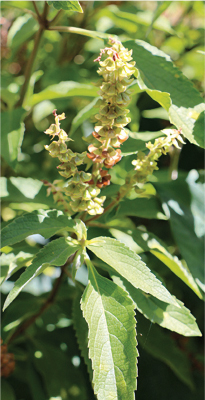
In India, sacred basil is considered to be the elixir of life. It is recorded in the ancient pharmacopoeias, verified by modern medicine, and grown to this day outside Indian homes and shrines for food, tea and its sacred healing presence. I was privileged to have been given my first sacred basil seeds by an Ayurvedic doctor who asked me to cultivate this holy plant and to share its remarkable uses for the benefit and support of people in this land. I made that promise to him, and continue to propagate it, to donate seed to community gardens, and to teach many people how to use it. And my daily cup of tulsi tea gives me energy and positivity – just as he said it would!
CULTIVATION
Plant the herbs 2 m apart in compost-rich soil. Water them three times a week in summer and twice a week in winter. The sprawling shrubs grow densely in both full sun and light shade, and thrive with picking. Tidy and prune as needed. Sacred basil needs protection in winter as it does not survive heavy frost.
PROPAGATION
Both seeds and cuttings are easy and rewarding. Sow the seed in spring and summer so the seedlings are strong before winter. Fill a seedling tray with good soil mixed with compost, and wet thoroughly. Sprinkle the seeds over the soil and cover with a thin layer of sand. Stand the tray in a bigger shallow tray of water to keep the seeds moist. When the herbs are big enough to handle, prick out and plant one or two into bags filled with good topsoil and compost, and keep sheltered until they are strong enough to plant out. Tulsi also grows easily from thumb-length cuttings pressed into wet soil and kept protected until the roots are set.
HARVESTING AND PROCESSING
Allow the sprays of seeds to mature on the bush to a brittle dryness before cutting them off. Crumble them and store in a paper bag.
CULINARY USES
Tulsi seeds are used to flavour bread; the fresh leaves are delicious in salads; and the dried seeds and leaves make a wonderful spice. Juice tulsi leaf with organic carrots, beetroot, celery, parsley and apple; it makes a vitality drink for all ages.

Tulsi tea gives energy and positivity.
MEDICINAL USES
Tulsi tea has been used for centuries to treat so many ailments, a whole book could be written about it! The tea is recorded in ancient pharmacopoeias as effective and reliable for the following ailments: kidney ailments and stones, coughs, colds, flu, bronchitis, high blood pressure, heart disease (under medical supervision), high cholesterol, liver ailments, asthma, colitis, allergies, fever, headaches, migraines, sinusitis and prostate disorders. Tulsi is considered to be a superb anti-ager and it reduces inflammation.
TO MAKE THE TEA: Pour a cup of boiling water over ¼ cup sacred basil leaves and flowering sprigs. Stir for five minutes, then strain and sip slowly. Usually 1–3 cups are taken daily for acute conditions and 1–2 cups for chronic conditions.
A daily cup of sacred basil tea also helps memory, muscular pains, cramps, diabetes, respiratory ailments, hip and back pain, rheumatism, trembling and weakness of the limbs associated with old age, and assists with weight loss, negativity, digestive upsets, constipation and acidity. It is said that those who take tulsi with a humble and devotional attitude derive miraculous benefits.
Sacred basil is my most-asked-for cream for all age groups. It relieves haemorrhoids, varicose veins, rheumatism and arthritis, bruises, sprains, aching feet and skin conditions like sores, eczema and sunburn. The cream restores health, and with a cup of tulsi tea it is amazing. Fresh leafy sprigs can also be used in the bath to ease pains.

Warm sacred basil cream in a bowl of hot water before using it.
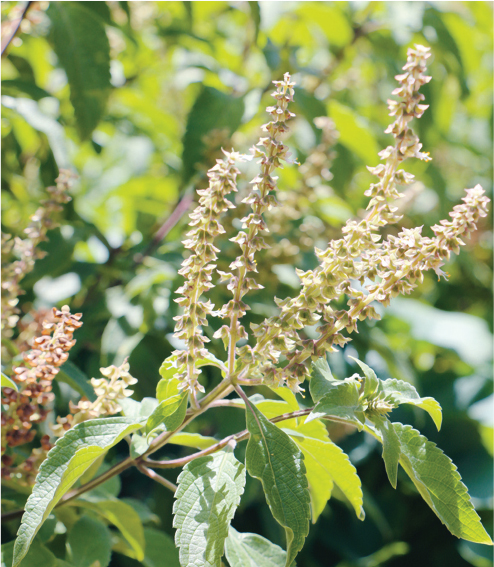
OTHER USES
Strong tulsi tea makes an effective insecticide for whitefly, aphids and ants. To make the brew, pour a bucket of boiling water over ¾ bucket fresh sprigs. Stir well and leave covered overnight. The next morning, strain and pour into spritz-spray bottles. It clears insects when used for three consecutive days.
Safflower
False saffron
Family Asteraceae
Species: Carthamus tinctorius
Origin: Asia, Mediterranean area
Plant: Annual
Height: Up to 1 m
Soil: Well-dug, well-composted soil
Exposure: Full sun
Propagation: Seed
Uses: Culinary, medicinal

Safflower was found in Egyptian tombs dating back to 3500 BC, and by AD 1061 the Chinese were using it as a traditional medicine. The flowers, known as ‘hong hua’, were listed as a valuable treatment for fever, pain, the heart, circulation and as an anti-inflammatory. It is remarkable how accurate the ancients were about these uses, without the complex medical research we rely on! Garlands of safflowers were found in Tutankhamun’s tomb. The petals were once used to dye the saffron robes of eastern monks, and to colour flax cloth and later cotton for trade. Today safflower is grown as a food, a trusted medication, and a natural dye.
CULTIVATION
Safflower is a robust, easy-to-grow annual, with prickly leaves and bright yellow, red and orange thistle heads. Each branch has up to five flower heads with 15–20 seeds per head.
Once established, water it twice weekly. It likes full sun and can be grown two or even three times during summer. In very hot areas, try it as a winter annual.
PROPAGATION
Sow the seeds in late August in deeply dug, richly composted soil, sprinkling the seed sparsely in rows. Water daily as the large seeds germinate quickly. Cover the rows with dried leaves and keep the seedlings moist. Thin out the seedlings if they are planted too closely. Replant thinned-out seedlings immediately and keep them shaded and moist.

Safflower seeds and petals can be added to many dishes.
HARVESTING AND PROCESSING
Pick the flowers throughout summer for their bright petals, rich in the pigment carthamine that makes a natural dye used in food and cosmetics. The petals can be used fresh, or they can be dried on brown paper for three days in the shade, and stored. Harvest the oil-rich seeds when the mature plants start to dry; store the seeds in glass jars with tight-fitting lids. Once you have reaped the flowers and seeds, pull up the plants for the compost heap as they are rich in minerals. Wear gloves when harvesting safflower as the prickles are uncomfortable.
CULINARY USES
The seeds are a valuable health food and can be ground with other seeds and sprinkled over Bulgarian yogurt, fruit salad and breakfast oats. They build the immune system and supply the body with valuable omega oils, vitamin E, and anti-oxidants.
Safflower petals and the tasty sprouted seeds can be added to stir-fries, soups, pancakes, scones, breads, milkshakes and jellies. The energising sprouts are rich in vitamins and minerals, and the petals can be used to colour foods such as cheese and white sauces, ice-cream, yoghurt and butter. Cold-pressed safflower oil is used in salads and cooking; it is valuable in cases of high cholesterol, and supports the heart and circulation. Unprocessed oil has a gentle, soft purgative effect.
Be aware that saffron (the most expensive spice in the world) is often adulterated by adding safflower petals. If you put the two together, side by side, you can see the difference, but in a mixture you could easily be confused.
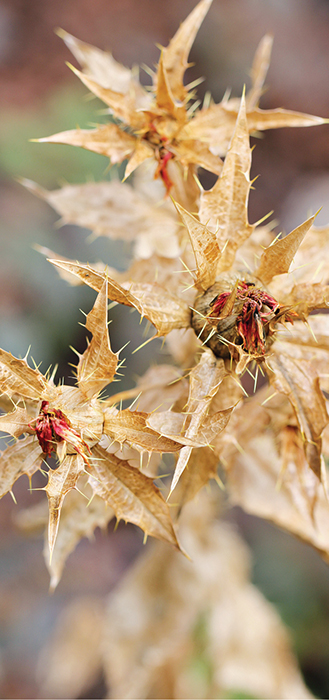
MEDICINAL USES
Safflower is well recorded and respected in Ayurvedic and Chinese medicine, where it is almost a holy herb, used in religious ceremonies, as a medication and as a health-building food. The Chinese favour safflower for treating heart ailments, gynaecological ailments, inflammatory conditions, fevers, pain, wounds, suppurating sores, swellings, sprains and backache. All these treatments have been listed in their pharmacopoeias for centuries!
In India, safflower tea is taken to relieve menopause problems, menstrual problems and jaundice. The plant is also used to treat bruising (as a poultice), as well as skin ailments, inflammatory conditions, painful joints and paralysed limbs (as a massage cream). The flowers are used for their laxative properties, and also to treat children for measles, fevers and skin conditions.
TO MAKE THE TEA: Pour a cup of boiling water over the fresh flower heads and petals. Let the tea stand for five minutes, then strain, sweeten with a touch of honey and add a squeeze of lemon juice if liked, and sip slowly. Take a cup daily for 10 days; if the problem persists, stop taking it for three days and then resume, always taking it for limited periods of 10 days.
WARNING: Do not use safflower in any way (even externally) if you are pregnant as it is a uterine stimulant. Always discuss home treatments with your doctor first.
Sand olive
Family Sapindaceae
Species: Dodonaea viscosa, Dodonaea viscosa ‘purpurea’
Origin: Subtropics worldwide
Plant: Shrub or small tree
Height: Up to 3 m
Soil: Any soil
Exposure: Full sun, light shade
Propagation: Seed, cuttings
Uses: Medicinal
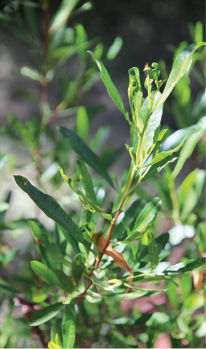
I have grown sand olive for close to 50 years and have found it to be one of the most useful albeit underused herbs. In its attractive purple form it has become a feature in many gardens, without gardeners knowing its virtues. It gets its name Dodonaea from the Flemish physician and botanist, Dr Rembert Dodoens, who recorded its many medicinal virtues in his herbal Cruydeboeck in 1554.
In Africa the sand olive is often used as a hedging plant, windbreak and decorative shrub. As a young farmer’s wife I learned from the herders and farm workers how they used sand olive tea to treat tick-bite fever, heat rash, sore throats, chesty coughs, sprains and backache. Years later in my herbal studies I discovered that it was used in many other countries too, in different ways, including the treatment of dysentery, digestive system disorders, skin problems and rheumatism.
CULTIVATION
Sand olives grow fairly quickly and can be planted out in full sun in a deep, compost-filled hole. They need a twice-weekly watering (once a week in winter), a twice-yearly dressing of compost, and trimming and pruning to keep in shape if needed; otherwise they can be left to grow to their natural shape. They can reach a height of around 3 m. The tree is an attractive feature in the garden, clipped into a ‘ball’; it can also be planted in a big pot, in which case it will need daily watering. I once planted a hedge of alternating green and purple sand olives and it made a spectacular boundary.
PROPAGATION
Seeds from the ripened cluster are dispersed by the wind, and seedlings sprout up everywhere. So once you have it, you will always have it. Cuttings can also be taken in early summer and planted in individual compost-filled bags.
HARVESTING AND PROCESSING
Pick fresh leafy sprigs to use as teas, or in the bath. As it is evergreen, the sprigs are available year-round. Save clippings for medicinal use and to make potpourri.
COMPANION PLANTING
Sand olive partners well with fruit trees, and most annuals planted nearby thrive. Violets grow happily in its shade.
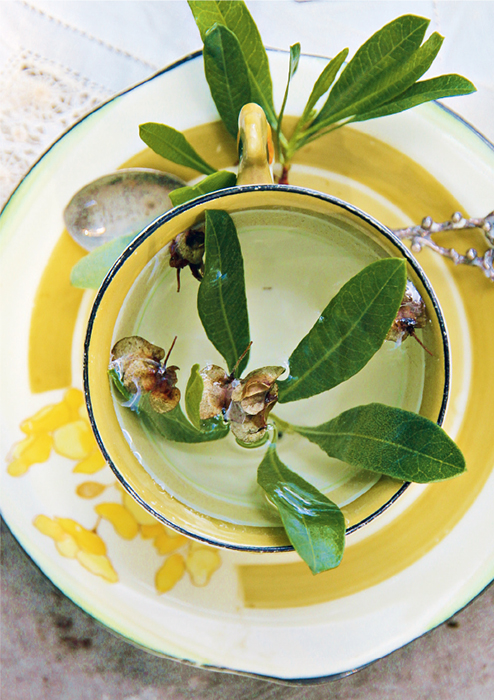
Sand olive tea is a remedy for headaches and fevers.
MEDICINAL USES
Sand olive tea is known worldwide; it was the first fever-reducing tea I was introduced to after a severe bout of heatstroke.
TO MAKE THE TEA: Boil a cup of fresh sprigs in a litre of boiling water for 10 minutes. Let it cool, then strain and add ice cubes (to bring down the fever), and sip slowly. Take a cup every hour until the headache is eased and the fever abates. If it is too astringent, dilute with iced water and more ice. A little honey can be added.
The tea (without ice and honey) has further common uses: it can be held in the mouth to relieve toothache, mouth ulcers or a sore throat; it can be used as a lotion to bathe a wound or soothe bee stings; and it can be sipped when there is indigestion and colic. I once saw how a farm worker’s multiple bee stings were treated and eased with pads of cotton-wool saturated with the lotion and placed over the stings, and the area constantly sprayed with the lotion.
A similar brew can be added to a lukewarm bath to relieve fever, headaches, sunburn, measles, flu, backache, hip pain, sciatica, muscle stiffness and the aches and pains of arthritis, rheumatism and old age. To make the brew, boil a large saucepan of sand olive sprigs in enough water to cover, for 20 minutes. Cool and strain before adding it to the bath.
I believe that much will be proven about this herb in the future. For instance, it is used as a treatment for haemorrhoids in Brazil, both as a tea and as a wash, and the Aboriginal Australians use the boiled leaves as hot as can be endured to bring a painful boil to a head. After the boil has burst, they use hot ‘tea’ to clean out the remaining pus, and make fresh batches of tea for the patient to drink three times daily to clear pain and infection. Sand olive tea is becoming a valued treatment for TB, and many rural people rely on the herb for pneumonia and bronchitis. I make a soothing cream with the sprigs to treat haemorrhoids, skin rashes, sunburn, bites, stings and infected scratches.

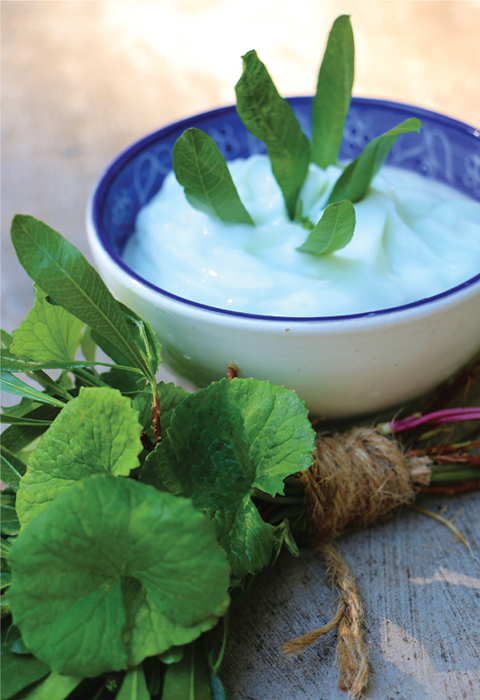
Sand olive cream soothes sunburn, bites and rashes.
Seville orange
Bitter orange / Naranja amargo (Spanish)
Family Rutaceae
Species: Citrus X aurantium
Origin: Southeast China, northern Burma, southern and Southeast Asia
Plant: Perennial evergreen tree
Height: Up to 8 m
Soil: Richly composted soil
Exposure: Full sun
Propagation: Nucellar budlines, rootstocks, seed
Uses: Culinary, medicinal, cosmetic
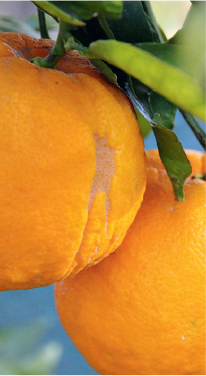
The Seville orange is one of the most disease-resistant, high-fruit-yielding and long-life fruit rootstocks. It is resistant to phytophthora root rot, and can grow equally well in wet and dry conditions; it is tolerant of salt and is the most cold-hardy of all rootstocks.
Bitter orange leaves are used to make petitgrain oil, while the flowers make exquisitely perfumed neroli oil, and the intensely bitter fruit makes orange peel oil. Most orange and mandarin crops are produced in Italy, Turkey, Greece, northern Africa, and South Africa.
CULTIVATION
Start your Seville orange tree in an extra-large hole filled with compost and topsoil. Set a wide plastic pipe into the hole at an angle so that a hose can be inserted and water can reach the roots. Water it deeply each week, twice weekly in very hot weather, to ensure a vigorous tree with an abundant crop.
PROPAGATION
The Seville orange is used as a rootstock in most countries but seeds from the bitter orange fruit germinate easily. The principal variety, the ‘Sevillano’, is grown by planting one seed per bag of rich soil. Keep shaded, moist and protected until it reaches the four-leaf stage. Then replant into a bigger plastic plant bag to establish strongly; move into the sun and keep protected and watered until it reaches 75 cm in height. Finally plant out in full sun, spaced 3–4 m apart.
HARVESTING AND PROCESSING
All parts of the evergreen tree are used, and harvesting of leaves, flowers and fruit is a year-round activity. Well-known Seville orange marmalade is still manufactured in several countries today.
COMPANION PLANTING
At the Herbal Centre we have found that catmint (Nepeta mussinii and Nepeta Six Hills Giant) keeps the bitter orange trees disease-free and the trees’ roots shaded and moist.
CULINARY USES
The intense bitterness and sourness of the fruit lends itself to marmalade, especially served with poultry dishes and cheeses. It also makes excellent dried candied peel to serve with desserts like pecan tarts, and with walnuts and macadamia nuts.
MAKES 6 JARS
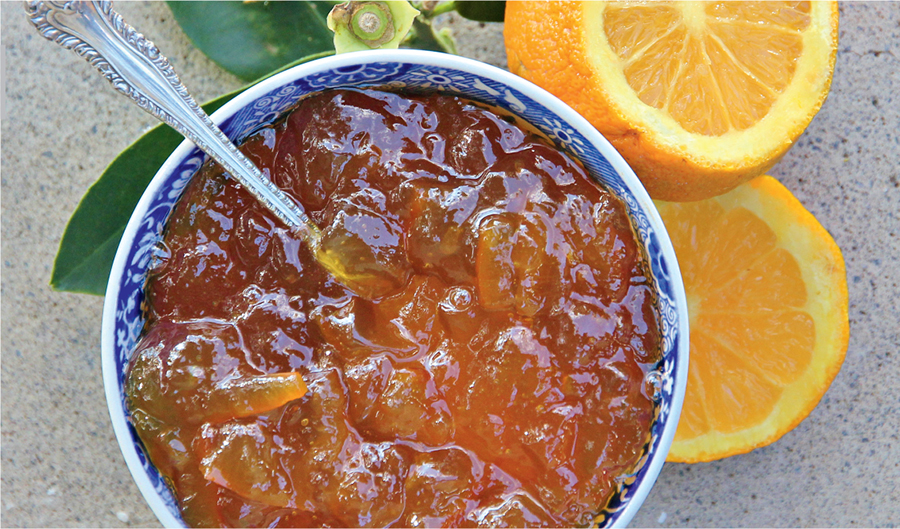
Seville orange marmalade
MEDICINAL USES
Prepared as a lotion, the fresh leaves make an excellent bath addition for aching muscles and for oily skin, acne and blackheads. Compresses of the hot lotion have long been used as a beauty treatment for clearing oily build-up and blocked pores.
Essential oil from the bitter orange leaves, known as petitgrain oil, has been used for centuries as an antiseptic, anti-spasmodic, digestive and tonic oil to treat insomnia, nervous exhaustion, stress, dyspepsia and excessive perspiration.
Essential oil from the flowers, named ‘neroli oil’ after the Italian Princess of Nerola, who wore it as an unforgettable perfume, has been used as a treatment for scars, thread veins, stretchmarks and for poor circulation, palpitations, diarrhoea, nervous dyspepsia, heartburn, premenstrual tension and emotional stress.
Neroli oil diluted in almond oil remains one of the best massage oils for reducing stress. The oil has deodorant properties and makes a wonderful foot massage oil and a muscle-relaxing deodorant for the whole body. Place six drops in half a cup of almond oil.
Orange oil from the fruit peel has anti-inflammatory, antiseptic, anti-bacterial, astringent, sedative and tonic effects, and is used as a treatment for insomnia, stress and indigestion, as well as muscular spasm and varicose veins.
A tea made from the fresh peel is a respected traditional medicine in China for dyspepsia, sleeplessness, flatulence, colic and bloating. The tea is also used as a fungicidal foot wash, and the thin shavings of peel steeped in oil have been used to clear athlete’s foot and toenail fungus.
TO MAKE THE TEA: Pour a cup of boiling water over two thumb-length pieces of Seville orange zest, carefully sliced using a potato peeler, and one Seville orange leaf. Add two thin slices of ginger root. Use honey to sweeten, stir thoroughly to release the precious oils and sip slowly. This tea is excellent for coughs, colds and blocked sinuses.
WARNING: Do not give Seville orange tea to children as it can have toxic effects. Use all essential oils with caution and never during pregnancy.
Silk tree
Albizia
Family Fabaceae
Species: Albizia julibrissin
Origin: Subtropical regions, Asia, Africa, Australia
Plant: Small short-lived tree, deciduous in cold areas
Height: Up to 6 m
Soil: Dry, deeply dug hole, thrives with compost
Exposure: Full sun
Propagation: Seeds, cuttings
Uses: Culinary, medicinal
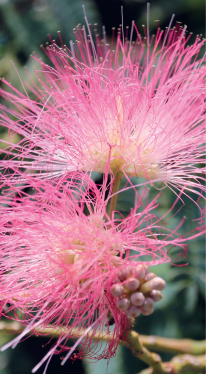
The silk tree was first recorded during the Tang Dynasty (ad 700) as a popular culinary and medicinal herb, with young leaves and flowers taken in teas and food, and as a calming, sedative herb. When it first reached Europe, it was considered a curiosity, with its pink shuttlecock flowers, and it was only later that it was recognised as a valuable medicine. The flowers were used to treat poor memory and became known as ‘memory flowers’ and also as ‘sedative flowers’ for their calming properties; thus they were probably one of the first tranquillisers. Today, the tree still features for its diverse medicinal uses, and specialist growers shape hedges and feature plants from its supple, spreading branches.
CULTIVATION
Plant out as specimen trees at least 3 m apart. Water slowly and deeply twice weekly in summer. Make a large ‘dam’ to contain the water and set a plastic pipe at an angle into the planting hole so that a hose can be inserted and water can reach the roots easily. This ensures a crop of lovely flowers and fern-like leaves; the longer and hotter the summer, the more flowers it produces. It sometimes flowers 3–4 times a year, depending on rainfall.
The silk tree shapes easily and can become a beautiful feature in a small garden. If left unpruned, its spreading, flat crown of branches gives it a fragile look, and in the kitchen garden it offers light shade for summer lettuces and spinaches. Severe pruning stunts its growth; pruning back 5–6 buds on the branches works well if you want to keep it small. It is a tough survivor plant and is frost-hardy.
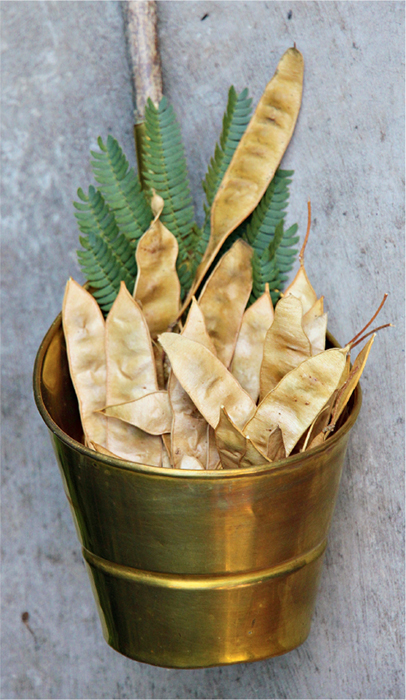
Collect silk tree seed pods for propagation.
PROPAGATION
The silk tree is prolific in viable seeds and can root from cuttings too. Cuttings need to be 25 cm long, pressed into most soil in individual bags and kept sheltered and watered every two days until ready to plant out.
HARVESTING AND PROCESSING
Pick flowers and leaves during the summer months. Flowers are picked in the evenings before the night dew touches them, as the hair-like ‘petals’ stick together when wet.
CULINARY USES
Culinary uses of the silk tree are legendary, with the flowers and fresh young leaves added to soups, stews, stir-fries and even lightly fried and sprinkled over baked potatoes, rice and breads. Dried leaves sold as tea make the basis for wonderful jellies with seedless grapes and deseeded cherries, and fresh flowers still grace salads in many cultures. Children seem to love them.
A delicious slimmer’s tea, served with crushed ice, is a favourite. Rather like a slushy ice-cream, the tea is served partially frozen in a small bowl, with the flowers tucked around like tiny shuttlecocks.
MAKES 4 GLASSES

MEDICINAL USES
The silk tree has diuretic, analgesic, astringent and sedative properties. It was probably one of the first tranquillisers, given as a tea to all age groups.
TO MAKE THE TEA: Pour a cup of boiling water over ¼ cup fresh leaves and flowers. Let the tea stand for five minutes, stir and strain. It has been taken for centuries to treat memory loss, sleeplessness, overactivity, irritability, ‘short-fuse syndrome’ and breathlessness, and as a digestive for colic, stomach cramps, heartburn and flatulence. It is safe for children; give them ¼ cup to start with.
To bring boils and abscesses to a head, take half a cup of the tea every two hours and make a hot poultice of the leaves tied in a cloth and applied with a hot-water bottle to the boil. Use the same poultice on sprains, strains and swellings, or use the silk tree healing cream. The cream is excellent for little children who are upset; it soothes restless legs, cramps and muscle spasms, and calms them to sleep. Tea made from the bark stimulates the circulation, the appetite and the uterus, so it is contra-indicated during pregnancy but was used in labour by the Chinese centuries ago to ease childbirth, always under a doctor’s guidance.
Silver cane berry
Himalayan raspberry
Family Rosaceae
Species: Rubus niveus
Origin: India, Himalayas, Burma
Plant: Perennial creeper
Height: Up to 3 m
Soil: Rich, deeply dug, well-composted soil
Exposure: Full sun, also partial shade
Propagation: Cuttings, seed from ripe fruit
Uses: Culinary, medicinal
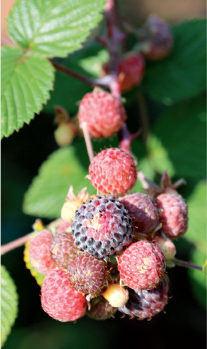
The great Rubus genus has many varieties and is found in temperate regions worldwide. Traditionally used as both food and medicine, the sprawling prickly ‘shrubs’ are strong health boosters that deserve a place in every garden. Within the genus, the Himalayan raspberry is a jewel. The leaves have medicinal properties and the delicious fruits contain pectin, fruit sugars, fruit acids and vitamins A, B1 and C. It is one of the most rewarding of all berry plants to grow as it fruits prolifically, not only in spring like its relatives but throughout the year, except in the coldest months. The berry is red when unripe and turns a rich purple-black when ripe.
CULTIVATION
Plant the young canes 2 m apart, in deep, richly composted holes along a fence (wear thick gloves). Once a fortnight, twist and guide the canes along the strands of the fence to facilitate picking. Prune and tidy as you go. Water slowly and deeply every three days, and mulch around the plants to keep the roots cool during our hot summers. As with all the berry family, the busiest time (propagation, tidying up, pruning and replanting) is in the winter months. This is when foundations are laid for the summer bounty. Thorns on the canes help to keep birds, squirrels and monkeys at bay.
PROPAGATION
Take 15 cm cuttings from existing canes and press 3–4 into deep bags filled with a mix of topsoil and compost that is moist and friable. Keep the bags in a protected position in a winter hothouse. Little buds and leaves appear quickly along the silver stems. Water on alternate days; take care not to flood the bags and check daily for dryness. Once the little canes are strong and full of leaves, move them into the sun for a short while daily, increasing the length of time gradually until they can take sun all day. Bring them into the hothouse at night until spring is well under way. Propagation by seed tends to be slow and erratic; however, at the Herbal Centre we find that seedlings come up in many places across the farm, started no doubt by birds. We often dig them up and replant them.
HARVESTING AND PROCESSING
The berry clusters of pretty pink flowers and berries of varying ripeness continue prolifically through the hot months. Pick daily to avoid losses from falling ripe berries. Harvest berries when they are fully ripe and not wet with dew or rain. Punnets of berries fetch a good price, and the Himalayan raspberry is a sure seller for the market gardener because it does not spoil as easily as other berries. Jams, jellies and syrups are also assured of a market.
CULINARY USES
The flavour-filled juicy ‘black raspberries’ are a gourmet treat, no matter how they are used. A bowl of freshly picked berries with a little honey and cream is the stuff dreams are made of – no one can resist! Jams, juices, jellies, pies and tarts are superb when made with these prolific berries throughout the year, and silver cane cordial is delicious served with crushed ice on a hot afternoon, or used as a syrup over yogurt, banana and apple for a great start to the day.

SERVES 2–4

MEDICINAL USES
All 200 species of edible Rubus berries around the world are delicious, and all have medicinal uses. The leaves contain tannins, polypeptides and flavonoids, and have been used for centuries in teas to treat diarrhoea, stomach discomforts, and in the case of raspberry, to ease childbirth. Silver cane berry leaf tea has been used as a mouthwash, a lotion to soothe chapped, dry skin, a wash for infected scratches and grazes, and as a wash for vaginal discharge.
TO MAKE THE TEA: Pour a cup of boiling water over ½ cup fresh silver cane berry leaves and stir well. Stand for five minutes, strain, and add a slice of ginger root and a touch of honey. Sip the tea slowly to ease stomach discomfort and indigestion. In our nursery we cherish this plant as it is so full of goodness.
High in manganese, the berry is an excellent treatment for osteoporosis, as manganese helps the body to absorb calcium, which in turn protects the bones and helps prevent osteoporosis. A weekly helping of silver cane berries in the diet has been found to ease menstrual pains, put colour into the cheeks of pale children, and build strong muscles, bones and circulation. It is a health food, with a great flavour.
WARNING: Do not take silver cane berry leaf tea internally or use it externally while pregnant.
Snapdragon
Family Scrophulariaceae
Species: Antirrhinum majus
Origin: Europe
Plant: Annual
Height: Up to 60 cm
Soil: Well-dug, well-composted soil
Exposure: Full sun
Propagation: Seed sown annually
Uses: Culinary, medicinal
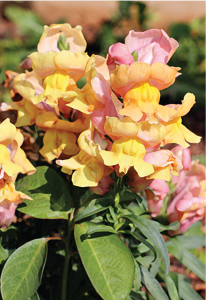
The snapdragon is native to the Mediterranean region, from Morocco and Portugal in the north to southern France, and east to Turkey and Syria. This attractive winter- and spring-flowering annual is an exceptional medicinal plant. Today, it is not as popular as in the past, when spring gardens were bright with snapdragons and children squeezed the flowers to open their little dragon mouths! In those days, no one knew that the flowers were edible, but we did know you could make a pleasant snapdragon tea and gargle for mouth infections and mouth ulcers. We also knew that it made an exceptional anti-inflammatory to ease aches and pains. The seeds are rich in oil and in past centuries monks pressed rose hips, snapdragons and lavender into a richly healing antiseptic oil.
CULTIVATION
In spring, plant out in rows 20 cm apart, in deeply dug, richly composted soil in full sun. Check the watering daily as now is the time the buds form, and spring weather can get warm. If necessary, stake heavy flowers if there is wind. Snapdragon flowers grow quickly and are long-lasting. Colours are pink, deep magenta, yellow, orange and white.
PROPAGATION
Sow seed in trays in late summer. The seed needs to be protected in a mini hothouse made by covering a frame with thick plastic. Gentle watering is essential in winter, just enough to keep the seed tray moist.
Prick out the seedlings as they mature and plant in single plant bags filled with moist compost-rich soil. Keep them warm and protected until the weather warms up and they can take sun all day.

Snapdragons in a row
HARVESTING AND PROCESSING
Pick the flowers as they open to add to salads and desserts. Use open flowers fresh in creams and lotions, in the bath, and to make compresses. Dried snapdragons store well in screw-top glass jars.
CULINARY USES
Use snapdragon flowers in salads, fritters, stir-fries, ice-creams and fruit salads. Strip off the little green calyx and float the flowers on iced fruit juices and sprinkle them on top of desserts. The flowers and buds are soft and tender to eat and become great favourites.

Snapdragon tea soothes a sore throat.
MEDICINAL USES
Snapdragon tea is a particularly soothing treatment for sore throats, strained voices (especially singers), and as a gargle for mouth ulcers, gum problems and sore throats. It can be swished around the mouth, gargled, held in the mouth and then swallowed. Contact with the tea will soothe and ease the pain of the condition.
TO MAKE THE TEA: Pour a cup of boiling water over ¼ cup fresh snapdragon flowers, buds and leaves. Let the tea draw for five minutes, stir frequently, then strain and sweeten with a touch of honey. Sip slowly, swill around the mouth, hold, and spit out. Use the whole cup this way and drink a little, too, as it is a calming tea.
Snapdragons are soothing for dry, itchy, red and inflamed skin. I make a healing snapdragon cream for rashes, sunburn, cracked heels, and rough skin on the hands and feet. Essential oils can be added; lavender and tea tree oil work beautifully. Use the cream generously as a moisturiser and to relieve inflammation. It is very comforting on burning haemorrhoids and aching varicose veins that are contused, and has a decongestant effect. Take a cup of snapdragon tea to clear things from the inside at the same time.
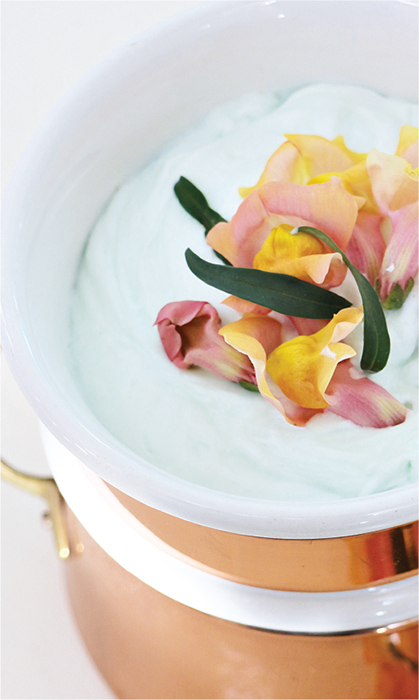
Snapdragon cream relieves inflammation of the skin.
For years my grandmother made a near-magical snapdragon poultice for aching joints. She would pick 3–4 fully flowering heads with a few leaves attached and pop them into a freshly washed cotton bag measuring 30 cm × 20 cm, with a drawstring at the top. The drawstring would be tightened and the bag submerged in a saucepan of hot water for 3–4 minutes. Still holding the drawstring, she allowed the bag to drip briefly, then wrapped it in a towel and applied it as hot as was comfortable to the painful joint or back, covered with the towel and kept warm with a hot-water bottle. The poultice did its work of releasing spasm and muscular aches. As a child I thought the healing was magical, not knowing the role of the medicinal flowers!
Spiderwort
Moses in the bulrushes
Family Commelinaceae
Species: Tradescantia virginiana
Origin: America
Plant: Perennial
Height: Up to 60 cm
Soil: Moist, rich soil
Exposure: Light shade
Propagation: Cuttings
Uses: Culinary, medicinal
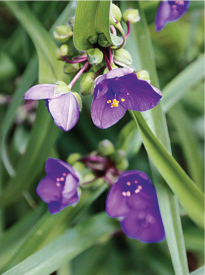
The common name ‘spiderwort’ is thought to derive from the plant’s angular leaves and stems that look like spider legs, and because juice from the base of the leaves was once used to ease the pain and infection of spider bites, long before more effective medications were discovered. It’s name ‘Moses in the bulrushes’ is thought to refer to the flowers, which are hidden between the leaves. It is also known as ‘The holy flower’ for its three petals suggesting the Christian Holy Trinity: the Father, Son and Holy Spirit.
It was once a popular pot plant due to its easy growth habit and edible flowers, and a landscaper’s dream because of its attractive and unusual appearance. It has recently become a collector’s plant and is enjoying unusual status as a ‘formaldehyde sponge’ and indicator of ambient radiation level. The original species was brought to England from North America around 1639, and was named Tradescantia after John Tradescant, who was a gardener to King Charles I and who diligently planted it.
Spiderwort flowers only last about half a day; however, flowers are produced in daily succession for several weeks.
CULTIVATION
Plant in a deeply dug, richly composted bed in light shade, spaced 30 cm apart, and make a ‘dam’ around each plant to hold water. Water 2–3 times a week; fill each dam slowly. Mist-spray the leaves and flowers too, as spiderwort is a soft and succulent plant that thrives with moisture. With the summer rains it can become so soft and tender that it flops over, but cut it back quite drastically and it will send out new stems continuously.
PROPAGATION
Once the flowers have faded and the whole plant lies sprawled, overgrown and untidy, clip back, tidy the clump and dig out side shoots. Work in friable, rich compost all around the clump. Water it in slowly and then take the cuttings: trim neatly and clip off just below a node, and press into a bag of well-composted topsoil. I press 3–4 cuttings into each bag. Keep them well watered and in the shade. The juicy stems grow easily and quickly. Once new leaves begin to grow and the little plants are sturdy, plant them out in the shade, in richly composted soil spaced 40 cm apart.
HARVESTING AND PROCESSING
Pick young stems and flowers as needed, all through the growing season. It is only used fresh or pickled, never dried.
COMPANION PLANTING
As spiderwort is an edible flower, I include it in the kitchen garden under the fig trees and cinnamon trees, where it gets dappled shade. New Zealand spinach thrives near it and remains insect-free. I have tried growing it in big stone pots in the shade of a mulberry tree and was pleased with the mass of flowers the plants produced. I remember seeing apples trained over arches in England with several of the small hybrid pink, white and mauve varieties of Tradescantia (T. × andersoniana) planted beneath the apples, and it looked spectacular and kept the soil cool and moist.
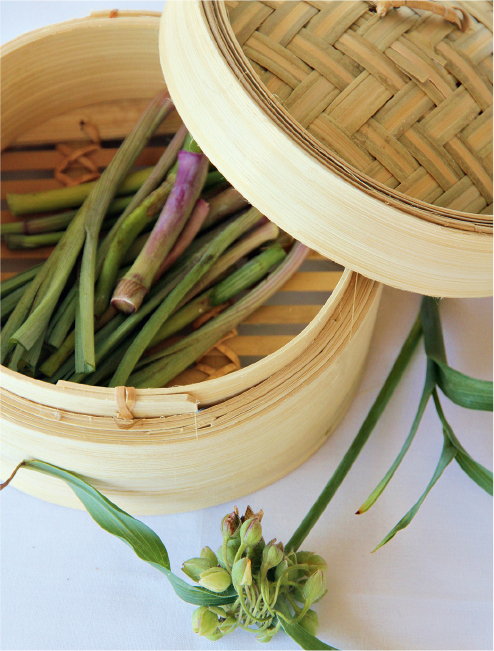
Steamed spiderwort
CULINARY USES
The edible flowers and buds are delicious in salads and fruit salads. They can also be stir-fried with onions, garlic and coarsely grated potatoes; served with sausages and garden peas, this makes a favourite lunch dish, loved by children. Traditionally in Virginia, USA, on feast days and holidays, the young stems and leaves were steamed as a green vegetable and served with a light mustard sauce. The chopped, juicy stems were also added to pickles and piccalilli relishes.
MEDICINAL USES
The peeled stem, exposing the moist and slimy inside, was used traditionally as a natural suppository for young children and babies suffering from constipation. A small piece of the stem was inserted into the anus. Continents apart, in Africa, rural tribes also used this family of plants as a suppository for constipation.
The soft juice of the crushed stem and leaf bases has been used for centuries to soothe red, sore rashes, grazes and stings. As this is particularly soothing for animals, some farmers grow spiderwort near stables and milking sheds.
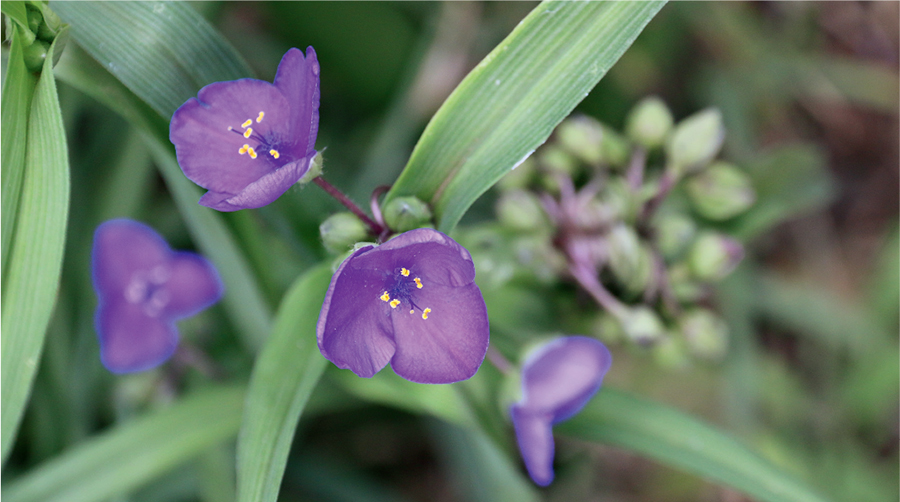
OTHER USES
A remarkable potential use for this plant was identified by NASA (the National Aeronautics and Space Administration) when scientists found that radiation levels can be detected by the spiderwort plant. As far back as 1977 it was noted that the blue-purple spiderwort flowers turned bright pink after exposure to sulphur dioxide, pesticides, vehicle exhaust fumes and household chemicals.
In 1978 the Environmental Protection Agency in America planted spiderwort along traffic circles on several busy streets to monitor the pollution, and all the flowers turned bright pink. Chemical-processing plants, and refineries, especially petroleum refineries, showed the highest rates of mutation.
NASA scientists have found that growing spiderwort plants en masse indoors helps to lower radiation, chemical and pesticide levels relatively quickly; the plants must be taken to a cleaner site to recover and the petals will return to their normal blue-purple colour. As chemical processing is a huge part of modern life, perhaps spiderwort is more valuable than we think.
Spilanthes
Paracress
Family Asteraceae
Species: Spilanthes acmella
Origin: South America, mainly Peru
Plant: Annual
Height: Up to 20 cm
Soil: Well-dug, richly composted soil
Exposure: Full sun
Propagation: Seed
Uses: Culinary, medicinal, insecticidal
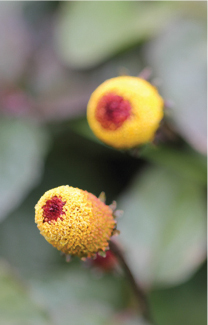
The spilanthes we grow today is a variety of the Brazilian cress or paracress that began its amazing journey under the watchful eyes of the Peruvians centuries ago. According to botanical records of paracress, its ability to numb the mouth and tongue led to extraordinary trade. Countries that adopted it have used it for centuries as a local anaesthetic and as a potent insecticide capable of killing mosquito larvae.
CULTIVATION
Plant out 30 cm apart in full sun. Spilanthes reaches around 15 cm in height, up to 20 cm if it is in rich soil, and it makes a neat border plant.
PROPAGATION
As spilanthes is a prolific annual and seeds are fairly easy to find, two or even three batches can be sown through the summer. In spring, scatter the seed thinly over trays of good topsoil mixed with a little compost. Sift fine soil very lightly over the seeds, and water the tray from below (stand it in a bigger tray filled with water) so as not to disturb the light-as-air seeds. Prick out when the seedlings are big enough to handle, and replant into bags or pots filled with compost-rich soil. Keep protected and shaded until the little plant becomes sturdy, and then strengthen by placing the bag in the sun for an increasing length of time each day until ready for planting.
HARVESTING AND PROCESSING
The fresh leaves can be picked at any time for salads and soups, and the tight flower buds for stir-fries too. Dried leaves can be stored for winter use. Pick the leaves and spread over brown paper-lined trays in the shade, turning daily until they dry, then store in large glass bottles with good lids to keep the leaves dust-free.
COMPANION PLANTING
Spilanthes does well with spring onions, Italian parsley, radishes, strawberries and mustard, as well as under granadillas and as an edging to asparagus beds. It seems to protect tender plants.

Add chopped, fresh spilanthes to butterbeans for an exciting taste.
CULINARY USES
Spilanthes is an exciting herb to use in flavouring exotic dishes. Try fresh spilanthes chopped finely with fresh coriander leaves, fresh parsley and a little crushed cumin. The Peruvians mix the finely chopped herb into a strong mustard sauce with fresh lemon juice, or dry and crumble it with crushed coriander seed, cumin seed and fennel seed, and use it sprinkled over mushrooms, grilled chicken or beef, and fish cakes. It makes a delicious condiment with coarse sea salt and black pepper. A popular braai salt can be made, with spilanthes as the ‘secret ingredient’.
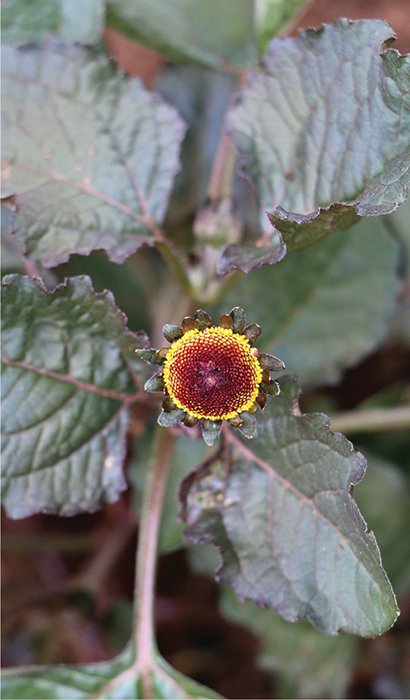
MEDICINAL USES
Spilanthes acts as an anaesthetic, particularly in the mouth. It numbs the entire mouth and has been found to help and heal gum disease, bleeding gums, toothache, mouth infections, mouth ulcers, herpes sores in the mouth and fever blisters. It also relieves indigestion, sour burping, colic, bloating and headaches, and its expectorant abilities are well documented, making it a useful herb for colds, flu, sore throats, tight chest, respiratory tract infections and bronchitis with excess phlegm. A tea made from fresh spilanthes leaves, sprigs and buds will help to relieve all the above ailments.
TO MAKE THE TEA: Simmer two cups fresh spilanthes sprigs in two litres of water in a heavy-bottomed stainless-steel saucepan for 20 minutes. Keep the lid on, but stir frequently. Top up the water if it reduces. Cool the tea for 10 minutes with the lid removed. Strain and keep in a covered jug. Pour a cup at a time; warm it in a double boiler if the weather is cold, or sip it chilled on a hot day. Hold the tea in the mouth as long as possible for mouth infections, gently swirling it around before swallowing. A little lemon juice and honey can be added, but surprisingly this mouth-numbing tea is enjoyed by most people – children included. The tea stimulates the salivary glands and in this way helps to clear mouth infections. In India, spilanthes flowers are used in a tea taken daily as a treatment for stammering children.
Spilanthes leaves can also be simmered in coconut milk (one cup leaves to 2–3 cups coconut milk) and applied on cotton-wool pads to rashes, itchy bites, blisters and light burns.
Strawberry tree
Family Ericaceae
Species: Arbutus unedo
Origin: Mediterranean area, southern Europe, Ireland, western Asia
Plant: Evergreen tree
Height: Up to 15 m
Soil: Well-drained soil
Exposure: Full sun
Propagation: Cuttings, seeds
Uses: Culinary, medicinal

(c) Javier Martin / Public Domain Wikimedia Commons
The strawberry tree was well known to Dioscorides and the early medicine men, including the Arabian physicians, who thought highly of it in the treatment of kidney ailments. It is also recorded as a valued and easily used herb for liver and heart ailments and diarrhoea, and some of the first anti-inflammatory liqueurs made by the monks were made from strawberry tree fruit and flowers. The tree deserves further investigation in the search for ‘new’ medicinal plants, as it has a strong antibiotic action, particularly against Mycobacterium bacteria.
CULTIVATION
Listed as a ‘glabrous’ (hairless) shrub, the strawberry tree grows 14–15 m in height, with smooth, pointed leaves and clusters of tiny, white, bell-shaped flowers, followed by marble-sized, orange-red berries. It thrives in full sun and in a frost-free or protected garden, out of the wind. A deep compost-filled hole, a long, slow, weekly watering, and a compost dressing twice yearly ensure a good crop of flowers and fruit. It can be pruned and shaped to last in a large pot, but it prefers full sun and a compost-filled hole in the open as it grows into a beautiful, dense evergreen tree with a wide crown.
PROPAGATION
Propagation is by means of cuttings or the dried, ripe fruit; both are reliable methods. Small cuttings no bigger than 10 cm in length seem to do best, but be prepared to wait as they are quite slow to set roots. I leave them where they are in their cutting tray for about 10 months, then prick each one out carefully and replant individually in compost-rich bags to grow to maturity. This often takes 18 months. Move them into the sun daily for an increasing time to harden off, before planting out in full sun.
HARVESTING AND PROCESSING
As it is a vigorous evergreen tree, leaves, flowers and fruit can be harvested at any time of the year and used fresh. The berries obligingly fall to the ground when ripe and orange in colour, so check frequently. The tough, leather-hard leaves need to be boiled for teas and washes.
CULINARY USES
The berries were used for many centuries to make jams, jellies and wine. In Sardinia they are still used to make a delicious spread with butter, honey and cinnamon; this is taken as a treatment to flush the kidneys and cleanse the liver, together with a tea made from the leaves. In the Middle Ages, strawberry leaf tea was made at the taverns for those who over-imbibed, and is still enjoyed today in rural areas. The tea is pleasant, and if served with fresh apple or grape juice it makes an enjoyable non-alcoholic drink, served hot or cold.
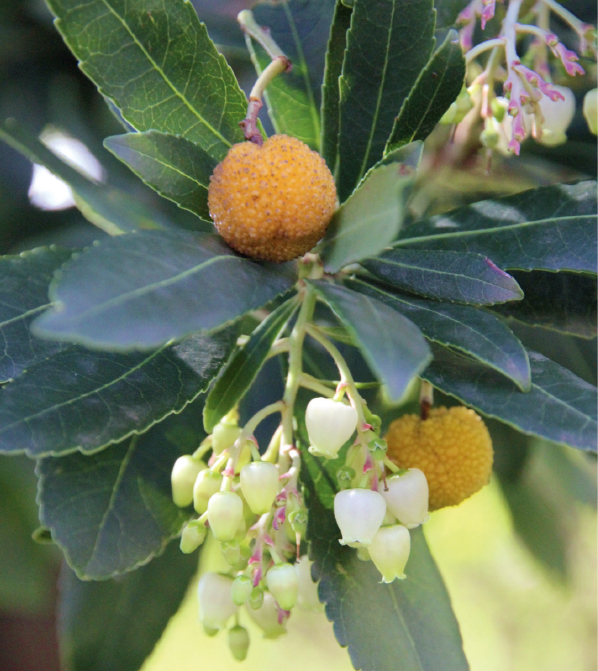
MEDICINAL USES
The action of this herb is most definitely liver- and kidney-cleansing. Strawberry tree tea is taken for liver and kidney toxicity, as a diuretic, for diarrhoea, and as treatment for arteriosclerosis. It is also taken for slimming, as a cellulite treatment, and to soothe the irritability the slimming process brings! Strawberry tree leaves also make an excellent antiseptic wash, lotion, poultice or gargle. It has been used for centuries to treat sore throats and laryngitis, to wash wounds, and to ease sunburn as a spritz-spray. Soaked pads were used over slow-healing rashes, grazes, light burns and infected mosquito bites, and on corns and callouses.
TO MAKE THE LOTION: Boil the leaves and stems in equal quantities of water for 20 minutes, then cool for 10 minutes and strain.
An excellent healing vinegar made from the leaves, flowers and fruit used to be part of every household’s medicine chest and was used, diluted with water, as a gargle for mouth infections and gum disease. A dash was added to the rinsing water after shampooing to cleanse the scalp, and it was used as a face wash to clear problem skin.
SERVES 6–8
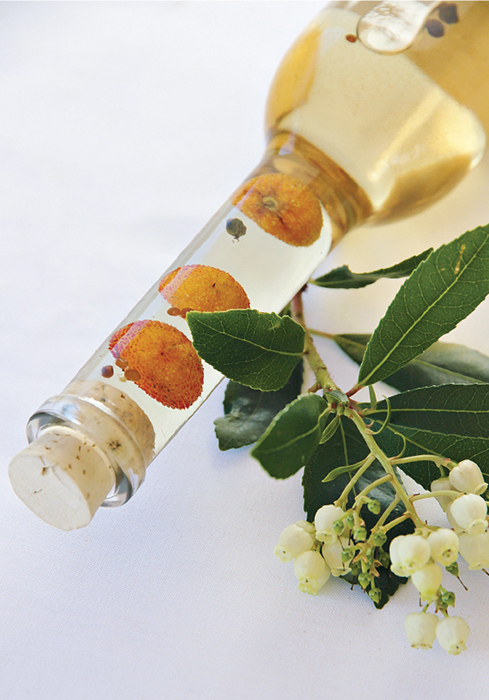
Strawberry tree vinegar
WARNING: Do not use strawberry tree during pregnancy or if suffering from any kidney ailments.
Sweet Annie
Chinese wormwood / Qing Ho
Family Asteraceae
Species: Artemisia annua
Origin: Vietnam, China, Korea, Russia
Plant: Annual bush, evergreen, feathery
Height: Up to 2 m
Soil: Unfussy
Exposure: Full sun
Propagation: Seed
Uses: Medicinal, insecticidal
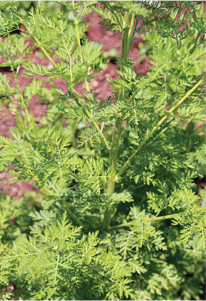
The Chinese have used ‘Qing Ho’ or sweet Annie for centuries to treat malaria. Recently a remarkable compound in the plant, artemisinin, has been found to be effective against malaria worldwide, and interest in sweet Annie has rocketed. The plant belongs to the large and varied Artemisia genus of around 300 species, most of which grow in temperate regions and have a bitter taste. In South Africa, Artemisia afra or African wormwood (often known as ‘wildeals’) is one of the oldest and best-known healing plants in the country, used for a wide range of ailments.
CULTIVATION
Space plants 1½ m apart in well-dug, composted soil, in full sun. Put mulch around the plant and water the shrubs 2–3 times a week in summer. Artemisia has a spread and height of up to 2 m, with feathery-leafed, soft branches spread open to catch the sunlight.
PROPAGATION
Seed is the only form of propagation; as a quick annual it sets seed quite easily, ensuring a good harvest. When the seedlings are big enough to handle, they can be dug up carefully and replanted into pots for further strengthening before being planted out in full sun. Keep the flowering tops in glass bottles and sow in spring.
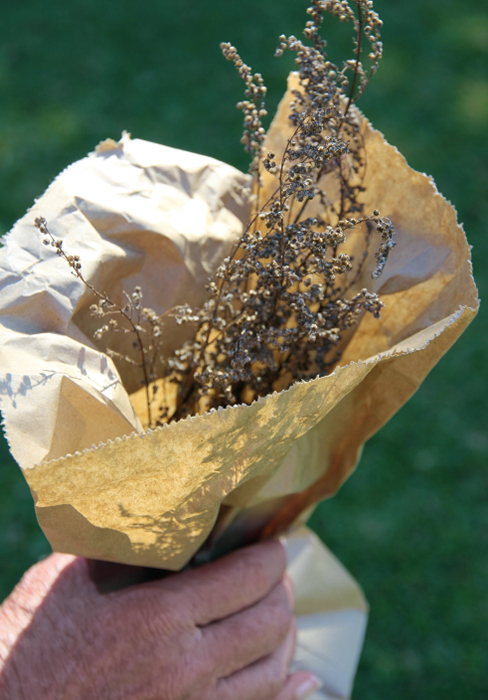
Sweet Annie dried seeds
HARVESTING AND PROCESSING
The shrub must be sturdy and well-established before being harvested for teas and lotions. Harvest leaves and sprigs before winter and dry for use through the cold months. Toss old, reaped plants onto the compost heap.
MEDICINAL USES
Sweet Annie is reaching star status as a malaria preventive and cure as it has a direct effect on the Plasmodium malariae parasite. Research in Thailand has found it to be 90 per cent more effective against malaria than the standard pharmaceutical treatment using the drug chloroquine. Infusions of the fresh and dried herb are used, but strictly standardised medications are vital for safe treatment. Malaria is a serious illness and needs to be under medical supervision.
Sweet Annie has also been found to have excellent antibiotic properties.
Sweet Annie tea is traditionally taken to relieve coughs, colds, bronchitis, flu and throat infections. The first writings in the Chinese pharmacopoeias recorded sweet Annie as a herb that ‘cleared and relieved the heat of midsummer’. Today’s research confirms that its cooling bitter properties have a temperature-reducing effect. In China and India, sweet Annie tea is used for heatstroke, high fever, night fevers and nosebleeds associated with heat. The cold tea sipped with crushed ice has become a well-known remedy in hot countries.
The same tea can be used cool as a wash for fungal skin infections, feverish infections, heatstroke, persistent rashes, infected mosquito bites, sores, grazes, infection between the toes, and as a gargle for mouth infections, gum ailments and mouth ulcers. Hold the liquid in the mouth as long as is comfortable, swishing it around frequently.
TO MAKE THE TEA: Pour a cup of boiling water over ¼ cup fresh sprigs. Stir for five minutes, then strain and sip slowly. It is a very bitter tea, so add honey and lemon juice to make it more palatable.

OTHER USES
In India, fine soft cotton pillowslips filled with fresh sweet Annie leaves are used in children’s beds to repel insects. The crushed leaves have a strong scent that acts as an insecticide. Sweet Annie insect spray has been a traditional anti-tick, anti-flea and anti-ant potion for centuries. It can also be a very effective spray for aphids, whitefly and even red spider. A similar spray, minus the soap, can be made for use inside the house; spritz-spray it over beds, curtains, windowsills and carpets to deter household pests. This spray is safe for children and pets, smells pleasant, and can be used to keep mosquitoes away. Do not spray directly onto people or pets.
Tamarind
Family Leguminosae / Fabaceae
Species: Tamarindus indica
Origin: Madagascar and tropical Africa
Plant: Evergreen tree; can be deciduous in cooler areas
Height: Up to 25 m
Soil: Well-composted, deeply dug soil
Exposure: Full sun, can take light shade
Propagation: Seeds
Uses: Culinary, medicinal
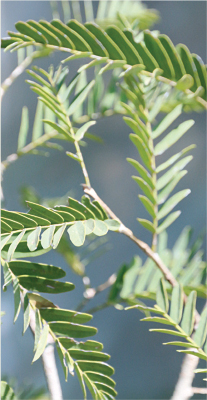
The word ‘tamarind’ derives from the Arabic ‘tamar-i-Hind’, meaning ‘date of India’, as the fruit pulp has a texture similar to dates. Considered to be a tree of blessing in its native Madagascar, tamarind now graces many tropical areas with its beauty. Prayers are written on ribbons and hung from its branches, and it is host to birds, butterflies and creatures seeking its nectar and shade. The fruit pulp is rich in plant acids and a complex and beautiful volatile oil that smells of lemon, rose-geranium, mint and even cinnamon. The seeds and leaves are rich in calcium and B vitamins, making tamarind a valuable health fruit.
CULTIVATION
Plant out in a wide and deep hole in full sunlight. Mix in liberal amounts of mature compost mixed with topsoil. Set a wide plastic pipe, at least 1 m long, into the hole at an angle, so that a hose can be inserted and water can be trickled down to the roots. A long, slow watering twice weekly will establish the tree well; build a ‘dam’ around the hole to help retain water. In winter, water once weekly and protect the little tree with a frost cover. Compost twice yearly and trim hanging branches if necessary.
PROPAGATION
I have found seeds to be the easiest way of propagation. Squeeze the seeds out of the fruit pulp, soak in warm water overnight, then boil for 3–5 minutes and plant three seeds into a large bag filled with moist topsoil mixed with compost. Be patient, as germination is slow away from the tree’s natural tropical coastal habitat.
Once the little tree puts out its first leaves, move the bags into good light but not direct sunlight. Keep a wire cage over the bag, as rats and mice can be a problem. Once the little tree is sturdy, with more than four leaves, bring it out into full sun for a short while each day, lengthening the time until it is in the sun all day.

Tamarind pod and leaf
HARVESTING AND PROCESSING
Pick the leaves as needed all through the year, or in cooler areas where it loses its leaves in winter, dry the leaves harvested at the end of the summer and store in glass bottles. Reap the fruit pods as they mature and ripen and dry. Store in glass bottles.
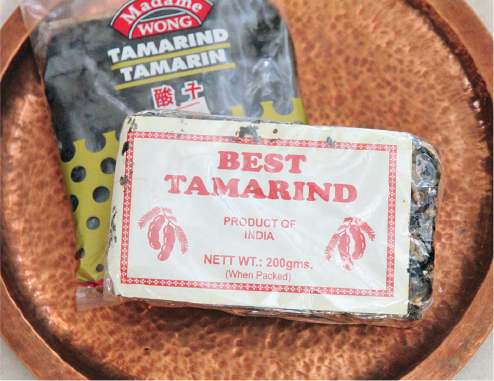
Tamarind products available commercially
CULINARY USES
In marketplaces, tamarind pods are often sold pressed into a rich, sour ‘cake’ or block. Pieces of the fruit can be cut off and melted into sauces, drinks, jellies, jams and sweetmeats. Exotically fruity and tart, it lends itself to both sweet and savoury dishes. It is used in curries, stews, chutneys, fish sauces and a variety of other delicious sauces such as Worcestershire sauce. Fish cooked with tamarind has an exquisite taste, and to this day tamarind is part of food folklore, with favourite dishes featured in every country where it grows.
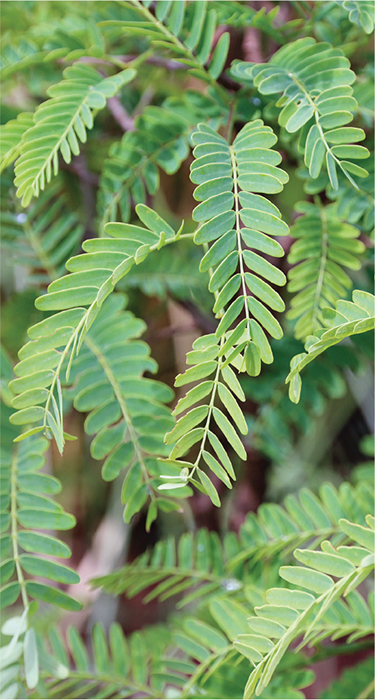
MEDICINAL USES
The marvellous, enriching oil in tamarind pulp makes it an excellent natural laxative, literally oiling the intestines. Only a little is needed in the diet to ease constipation. It is recorded in the pharmacopoeias of many countries for this purpose and is safe for children and the elderly too.
In cases of diarrhoea, colic, flatulence, nausea and tummy upsets after eating rich food, tamarind tea (without honey) should be taken comfortably hot and sipped slowly. Tamarind leaf tea is also a pleasant way of treating stomach ulcers, fevers, liver problems, and morning sickness during the first months of pregnancy. Tea made from the leaves and fruit is also excellent for asthma and it is a strong antiseptic. Taken as a tonic tea, it protects against ageing and relieves daily stresses, aches and pains. It is being newly researched as a treatment to remove excess fluoride from the body; worth looking into.
TO MAKE THE TEA: Pour a cup of boiling water over 3–4 fresh leaves and a few flowers, if you find them. Stir for five minutes, then strain and sip slowly. Add a teaspoon of tamarind pulp, if liked, and a touch of honey. Cool baths made with tamarind’s soft leaves and flowers restore balance and lessen fevers.
Taro
Madumbi, yam
Family Araceae
Species: Colocasia esculenta
Origin: India, Southeast Asia
Plant: Tuber, perennial
Height: Up to 1 m
Soil: Rich, moist soil
Exposure: Light shade, full sun
Propagation: Tubers
Uses: Culinary, medicinal
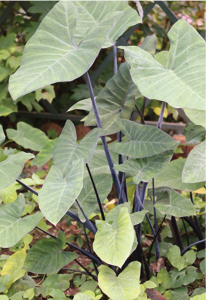
The robust and easy-to-grow taro is a valuable plant for building energy and strength. The underground tuber is filled with nourishment, and the young leaves are nutritious too. The safest way to start your own taro is to look for autumn taros in your local market or greengrocer shop. The taro is like a potato, only it has a brownish, flaky skin, resembling thin bark, and usually comes packed in a box of eight tubers. These can be planted; the emerging leaves are smooth, big and beautiful. There are several cultivars of this ancient food, also known as ‘madumbi’ in South Africa. It was grown in Southeast Asia as a staple for over 10 000 years. Later, Portuguese and Spanish explorers took it to the Mediterranean, Africa and the new world, where it remains a favourite food today.
My own taro plantings started when I traded air potatoes for the precious taro brought by Chinese visitors, who told me that it is the oldest food in China. I subsequently extended my taro plantings with tubers bought from the Asian stores and markets, and often cook taro with the delicious fish recipes from the Pacific Islands.
WARNING: Taro leaves look like elephants’ ears; be very careful not to confuse taro with the ornamental ‘elephant ear’ plant; the latter is poisonous.
CULTIVATION
Start the tubers off spaced 50 cm apart in deeply dug, richly composted soil. At the Herbal Centre gardens we grow two different varieties, some in the sun and some in light shade. Run a gentle, slow hosepipe into the roots every week, and mulch the area thickly with leaves to retain as much water as possible. Taro is sometimes sold as an exotic ornamental – with no information on the valuable tuber growing under the ground.

Once the large, potato-like tuber of the taro root is removed, replant the stems.
PROPAGATION
Propagation is always from tubers, dug up at the end of summer.
HARVESTING AND PROCESSING
In tropical regions, harvesting can be done at any time. Both the leaves and tubers have culinary and medicinal uses.
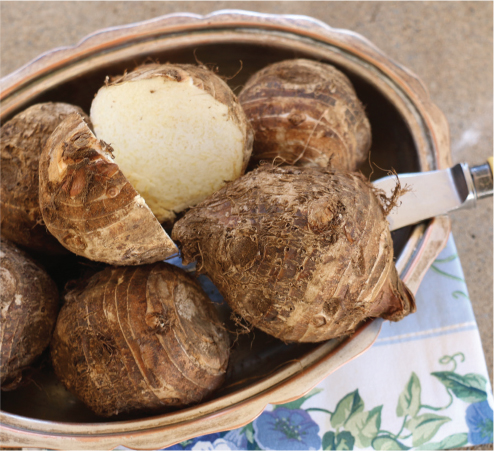
CULINARY USES
Taro leaves are cooked like spinach or used to wrap chicken and rice for steaming. Tubers need to be peeled, rubbed with lemon juice and a little salt and roasted, steamed, boiled or mashed to make the traditional dishes that are so much part of life in the tropics throughout the year. They are rich in vitamin C, iron and phosphorus and their high carbohydrate content is energy building and easily digested as the starch grains are small. Taro fritters, chips and French fries are popular in many tropical countries, used much as potatoes are used in other parts of the world. The tubers are also added to stews, roasts, soups and vegetable dishes. The plant must be cooked to break down the calcium oxalate crystals present.

MEDICINAL USES
Hot, mashed, well-cooked taro is a very useful external poultice over a boil, an infected wound, a graze or a sprain. Spread it as hot as can be tolerated over the area and cover with a warmed taro leaf, held in place with a crepe bandage or a towel. Allow it to draw for at least an hour, then gently remove and wash the area with pads of cotton-wool soaked in hot water and a little antiseptic. Discard each pad after wiping the area, and use new ones until the skin is clean.
In the case of a sprain or strain, apply a warmed fresh leaf. Soak the leaf in hot water for 10 minutes before applying it, as hot as is comfortable. Bind it in place with a crepe bandage, and rest for 30 minutes. The soft leaves have been used in this way for centuries and were popular with the ‘barefoot doctors’ in China. Taro cream can be applied under the hot leaf poultice; this is a useful pain-relieving cream used to massage into strained muscles or a sprained ankle.
Thai lime
Makrut lime / Combava
Family Rutaceae
Species: Citrus hystrix
Origin: Southeast Asia
Plant: Evergreen, small tree
Height: Up to 2 m
Soil: Deep compost-filled hole
Exposure: Full sun
Propagation: Cuttings, seed
Uses: Culinary, medicinal, cosmetic
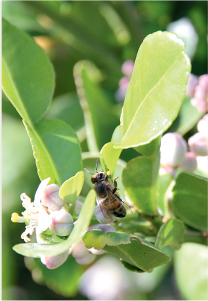
This fascinating small citrus tree, cultivated in Sri Lanka, Malaysia and Thailand, is becoming established in many other warm areas, including South Africa, where it flourishes. Rind of the small knobbly fruit has long been used as a medicine. Old pharmacopoeias indicate that oil from the fresh and dried rind, as well as the leaves, were ingredients in popular remedies. The fruit and leaves were also used as a treatment for scurvy on sailing ships, and the oils and tiny fragrant flowers were among the first beauty treatments offered for sale, particularly for inflamed sun- and wind-burned skin. The rough skin of the lime has been likened to a crocodile’s eyebrows!
CULTIVATION
Thai lime thrives in full sun in a wide, deep compost-filled hole and needs a long, slow, weekly watering. It does exceptionally well in a frost-free environment. Chefs and gardeners in colder areas should plant it in a pot against a hot north-facing wall where it can be protected with a fleece cover in winter. It is undemanding, neat, attractive, evergreen and laden with fruit – a valued addition to the cook’s garden. It needs no pruning and attention other than watering and a good barrow of compost twice a year, and can take a little shade in the afternoons. Thai lime leaves are distinctive and look like a double leaf as the stalk wing is almost the size of the leaf.
PROPAGATION
Take thumb-length cuttings from year-old growth and press them into wet sand. Keep moist and protected. Once the little plants are sturdy with new leaves forming, gently prick them out and plant into pots or bags filled with compost-rich soil. When they are established, bring them out into the sun, increasing the time daily until they are strong. Then plant out.
To grow from seed, press the pips into moist soil in bags or pots, three seeds to a pot. Keep moist and protected, out of the sun and water daily. The seeds take a long time to germinate, but after germination the little tree grows quite fast.
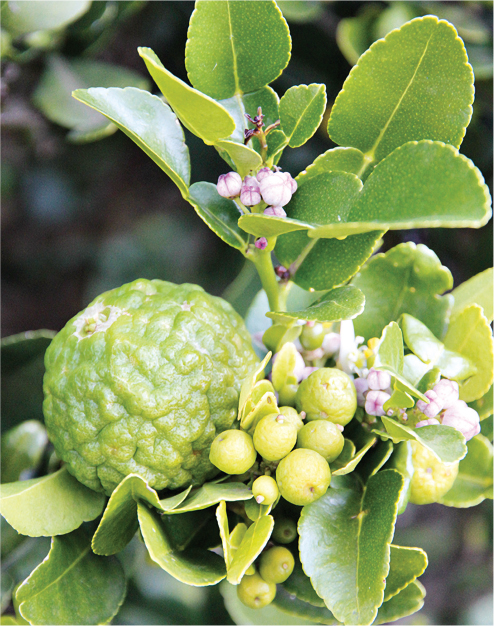
HARVESTING AND PROCESSING
Harvest fresh leaves at any time of the year; fresh is really the only way to enjoy the exceptional flavour in the leaves. Fruit is also harvested fresh and keeps well in the fridge.
CULINARY USES
The finely grated rind is rich in oils and adds a gourmet flavour to many dishes. The fruit has hardly any juice but thinly sliced (fresh or dried) it gives deliciousness to stews, teas, sauces, curries, drinks and syrups, and invites experiment. Finely shredded leaves can also be added to many dishes – the next time you cook curry, rice or a stir-fry, add a few finely sliced fresh Thai lime leaves and taste the difference.
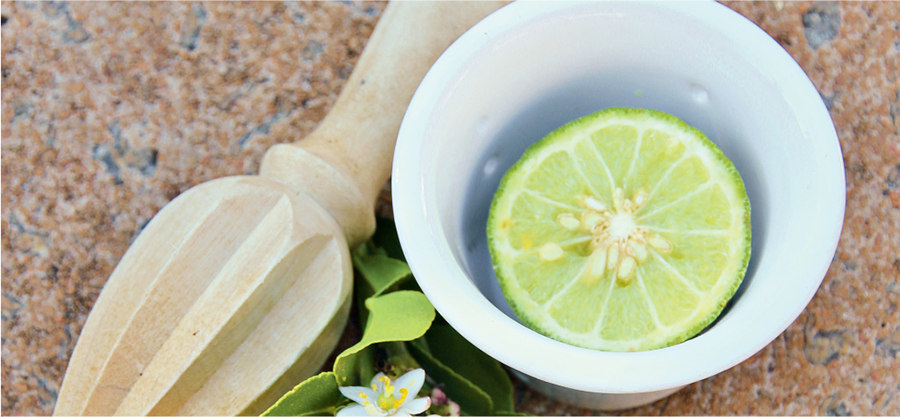
Thai lime makes an excellent digestive tea.
MEDICINAL USES
Thai lime tea is soothing at the end of a tension-filled day and as a treatment for a cold or cough. It also makes a perfect digestive tea.
TO MAKE THE TEA: Pour a cup of boiling water over a slice of the fruit together with three cardamom pods, three cloves and a little piece of cinnamon. Let the tea stand for five minutes, then stir well, strain and sip slowly during and after a meal.
Thinly pared fresh fruit peel, leaves and coarse salt can be tied in muslin to use in the bath for rough, dry skin. This age-old remedy is still popular. In Sri Lanka and Thailand, travellers are offered a traditional healing footbath made from sliced fruit and crushed leaves with salt and hot water. A refreshing hair rinse can be made that cleans the scalp and gives the hair shine.
For centuries, Thai lime fruit rind and juice were pounded into a paste and used as a rub on the legs and feet to kill leeches, ticks and fleas. An effective insect-expelling cream can easily be made this way.
WARNING: Always test a little of any home-made cream on the inside of the wrist, as some oils may affect sensitive skins.
OTHER USES
Thai lime is considered to be a plant of protection and traditionally it is grown near the entrance to the home. The leaves and fruit are rubbed across the doorstep to keep snakes, rats and insects away.
The dried fruit can be tucked into pantry shelves, and added to flour bins and tins of rice to keep weevils out and to add flavour.
Vervain
Family Verbenaceae
Species: Verbena officinalis
Origin: Europe, Africa, West and Central Asia
Plant: Waste-ground weed
Height: Up to 40 cm
Soil: Any soil, unfussy
Exposure: Full sun, light shade
Propagation: Seed
Uses: Culinary, medicinal

Vervain belongs to the Verbena genus and has been an official medication through the centuries (remember that the word officinalis in a plant name indicates this). The herb is revered in both Germanic and Celtic cultures and has sacred and magical associations.
It was first given to me by a Dutch visitor as a sacred herb to bless the garden, and has grown here prolifically for 30 years. Tenacious and self-seeding, it is a valuable healing plant for our times and the century ahead.
Vervain is also known as ‘herba sacra’, or the sacred weed. It was carried as a good omen during Rome’s peace negotiations and taken as a shared tea during the talks, as it was known to be calming and healing. Later ‘herba sacra’ was grown in the cloister gardens of churches and used in the monks’ dispensaries. Extracts are still used today to flavour the French liqueur ‘Verveine du Velay’, which is bitter, aromatic and cooling. A mere teaspoonful is taken in a little hot water for feverish illness.
CULTIVATION
Plant out in full sun or light shade, in well-dug, well-composted soil. Afternoon shade is preferable. Give a good watering twice a week.
Three-, four- and five-year-old plants can be cut back once the seeds have been dispersed, and new compost can be dug in lightly around the area. Watered well, the tough old perennials soon shoot new leaves. I always tidy up the clumps at the end of winter, once the warmer weather starts. Vervain withstands the cold well.
PROPAGATION
Seed is the only means of propagation, and young seedlings transplant easily, so I allow it to self-seed. When seedlings come up in spring, transplant them into bags to re-establish before planting out permanently.

Vervain’s untidy seed heads at the end of summer
HARVESTING AND PROCESSING
Cut fresh sprigs as needed for teas. Dried vervain appears in several of the old herbals and was stored in glass jars for winter ailments.
CULINARY USES
Dried flowering vervain sprigs are used in Turkey to flavour salt. Vervain tea (see below) made with lemon, honey and ginger is not only pleasant, but imbued with the peace and healing of the ‘herba sacra’.
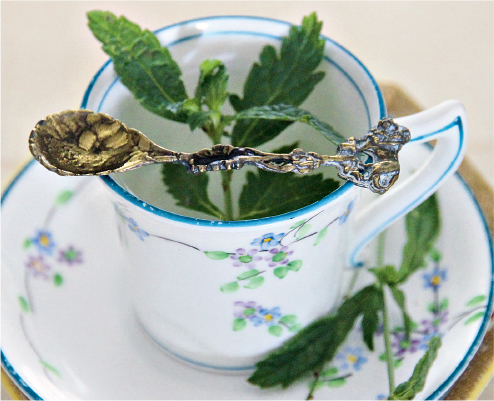
Vervain tea helps for stress-related ailments.
MEDICINAL USES
Vervain has been taken as a medicinal tea for centuries and is helpful for so many of the ailments we suffer from today in our stressful world: nervous exhaustion, depression, liver ailments, gallbladder ailments, migraine, asthma, convalescent debility, and insufficient lactation in nursing mothers. One cup a day is sufficient as it is a powerful herb.
TO MAKE THE TEA: Pour a cup of boiling water over ¼ cup fresh or dried herb. Let the tea draw for five minutes, stir well and then strain. Sweeten with honey and add a squeeze of lemon juice if liked, and a little grated ginger for a feverish cold.
The tea is also excellent as a mouthwash for bleeding gums, gum disease, gum ulcers, and cracked tongue. Take a mouthful, swish it around in the mouth, hold it as long as is comfortable, swallow a little, and spit out the rest. Use the cooled tea externally as a wash for eczema, cuts, grazes and bruises, and use the tea both internally and externally for certain tumours.
In China, the tea is used extensively to treat malaria, fevers, gum diseases, bladder and urinary disorders, flu and bronchial infections, aches and pains, abscesses and boils, infected sores, certain tumours and indigestion. It is also used to increase perspiration during bouts of flu, to reduce infection, control bleeding and to improve the function of the gallbladder. Its painkilling abilities are well recorded for headaches and migraines.
Excessive intake of vervain tea can cause nausea and vomiting, so adhere to the recommended dose. In the case of children and the elderly, give half a cup twice daily (divide the one-cup dose into two). The liver, gallbladder and spleen all respond positively to a cup of vervain tea per day for 6–10 days. Stop for 3–4 days as soon as the patient feels better, and then continue if needed, although usually 6–10 days are sufficient.
TO MAKE VERVAIN LOTION FOR THE BATH: Boil four cups of fresh, chopped leafy sprigs in two litres of water, and simmer the brew for 30 minutes. It makes a most soothing addition to the bath to ease all the above ailments.
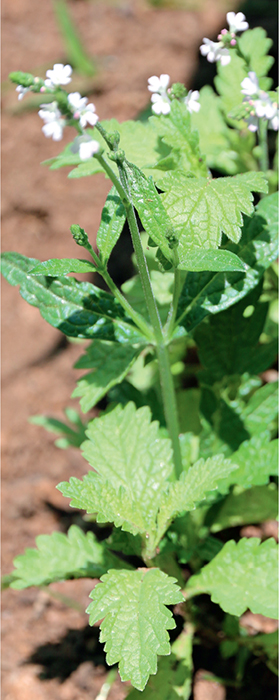
Vervain showing young spring growth
WARNING: Do not take vervain during pregnancy as it stimulates the uterus. The herb is said to ease and facilitate contractions during labour, but only take it under a doctor’s guidance.
Do not confuse vervain with lemon verbena, as they are entirely different plants!
Vietnamese coriander
Laksa leaf / Asian mint
Family Polygonaceae
Species: Persicaria odorata (odoratum)
Origin: Southeast Asia
Plant: Spreading perennial
Height: 30–40 cm
Soil: Richly composted soil
Exposure: Light shade
Propagation: Cuttings
Uses: Culinary, medicinal
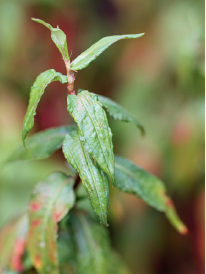
Vietnamese coriander often has a dark maroon mark on the leaves near the base, giving it its distinctive look. It is always served fresh, heaped generously on a bowl of soup or noodles, imparting its rich, coriander-style flavour. Once tasted, never forgotten; this herb is unique and beautifully versatile.
Medicinally, Vietnamese coriander has been used in Asia for centuries. It is listed in the first herbal texts as a digestive, as an elixir for overindulgence in alcohol and rich food, and for ‘behaviour excesses’.
CULTIVATION
This sprawling perennial thrives in cool, partially shady, richly composted places where it roots at all the nodes touching the ground. The more you pick, the more it grows, except in midwinter when it almost disappears from sight, but after a good mulching it appears again in spring. It is a rewarding herb for the kitchen gardener as it grows so easily. Like the mint family, laksa constantly seeks nourishment and new ground. Water it three times a week and cut back sprawling growth twice in summer. Give it rich compost and rock dust four times a year.
PROPAGATION
Stand a bunch of fresh stems in water overnight. Next morning, strip the lower leaves off the stem and press at least two nodes into soft, moist, compost-rich soil. I do three cuttings per pot. Stand the pots in a tray of water so that the soil does not dry out and in about six weeks the roots will have become strong and you can plant out the cuttings in a water-filled hole dug into richly composted soil in light shade. They will quickly send out new shoots. Water well until established; thereafter water twice weekly.
HARVESTING AND PROCESSING
Pick and use laksa leaves fresh as they lose their unique taste if they become dried out.

Add laksa leaves to salad with mango, lime and shredded cabbage.
CULINARY USES
Include vitamin- and mineral-rich laksa leaves often in the diet. Its fresh and tantalising taste appears in many traditional dishes, including chicken, fish cakes, fish stews and soups. Experiment with laksa leaves in stir-fries, spring rolls, salads, vinegar sauces, and creamy cheese and mustard dips. Laksa leaf-flavoured vinegar is a favourite salad dressing. Press sprigs of fresh laksa leaves into a bottle of brown grape vinegar. Shake it up daily; after two weeks it will have a rich taste.

Chicken noodle soup with Vietnamese coriander
SERVES 6

Laksa tea with lime and honey
MEDICINAL USES
Traditionally, a tea made from Vietnamese coriander was considered to be the best way of treating any number of ailments, including moodiness, sexual excesses, disruptive temper tantrums, disrespect and ‘un-cooperativeness in the citizen’!
TO MAKE THE TEA: Pour a cup of boiling water over ¼ cup fresh leafy sprigs. Let the tea stand for five minutes, stir and press the leaves, strain and sip slowly. A cup was taken morning and evening after eating.
The essential oil extracted from the leaves, known as ‘kesom oil’, is used as a medicinal oil for spasms, tension, indigestion, hiccups and anxiety. Added to a carrier oil, it was a commonly used remedy by the Chinese ‘barefoot doctors’ (5–10 drops kesom oil to one tablespoon of almond oil).
In the late 1960s, a remarkable system was established in China. Young men known as the ‘barefoot doctors’ were given basic training in herbal medicine, acupuncture and Western medicine, and were sent out to practise in remote areas, using the plants found in the region. This became a model for the World Health Organisation, and gave authority to the much-used and respected herbal medicines. Laksa leaf massage oil was a medication used by the ‘barefoot doctors’.
Wall germander
Teucrium
Family Lamiaceae
Species: Teucrium chamaedrys
Origin: Central and southern Europe
Plant: Perennial, evergreen
Height: Low-growing bush, about 40 cm
Soil: Well-dug, well-composted soil
Exposure: Full sun, can take light shade
Propagation: Cuttings
Uses: Medicinal, flowers are edible
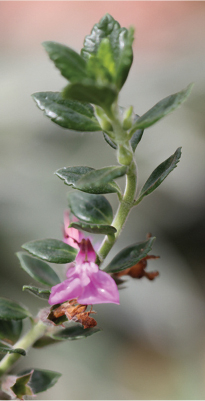
I have grown wall germander for 50 years. It is a cosmopolitan genus and does well in the African heat. I consider it a tough survivor plant as it has adapted from its beautiful Mediterranean homeland and crept sturdily into many places in the herb garden, enchanting every grower. It is popular with landscapers as a reliable, controllable and attractive border plant, with its pretty pink, typically Lamiaceae flowers and tiny, dark, glossy leaves.
Wall germander has been used medicinally since ancient times, particularly in Greece where Dioscorides prescribed it for asthma and tight coughs. It was recorded in ancient pharmacopoeias as a treatment for ‘falling sickness’ (epilepsy), chronic headache, melancholy, convulsions, ‘palsies’ and sleeping sickness. The English herbalist, Culpeper, used it as a ‘melancholy treatment’ as well as for convulsions and palsies, and considered it a herb of great repute. Today it is seldom used, except to flavour liqueurs, tonic wines and vermouths in central and southern Europe.
CULTIVATION
Wall germander is an unfussy perennial and a free-flowering plant. In spring and early summer it has little spires of pink flowers. Watering is essential 2–3 times a week in very hot weather. The herb thrives with a dressing of compost or rock dust several times a year, dug in around the clump and watered in thoroughly. It roots readily, establishes in a short length of time, and withstands frost and cold throughout the winter.
PROPAGATION
Separate rooted sprigs off the clump in spring, or take cuttings from the spreading stems at any time of the year. Replant them in bags filled with moist compost and topsoil. Keep the bags protected and moist until each little plant is sturdy and ready to be planted out.

HARVESTING AND PROCESSING
Pick sprigs, with or without flowers, at any time of the year to make teas. The herb is evergreen, so fresh sprigs are always available.

Wall germander tea
MEDICINAL USES
Wall germander is an astringent herb, recorded as having anti-rheumatic and anti-inflammatory properties. Taken as a tea, it stimulates and assists the digestive process, lowers fevers, and clears nasal catarrh, coughs, colds and bronchitis. Surprisingly, it helps with weight loss. It has remained a favourite herb through the centuries for this purpose and is still occasionally found as an ingredient in weight-loss medications. (Only use it under a doctor’s supervision.)
The tea is also used three times a day as a mouthwash for infected, bleeding, spongy, sore and ulcerated gums, and cracked sore red tongue. Hold a mouthful of wall germander tea in the mouth, swill it around gently, wait a minute, then spit it out. Do this directly after a meal, using half a cup of tea. This remarkable treatment has proved to be most effective, and usually improves mouth health within a few days. I have often searched for wall germander (or its Latin name, Teucrium chamaedrys) in toothpaste ingredient lists and never found it. It would benefit so many who struggle with frequent mouth infections.
Take half a cup of wall germander tea twice daily as a decongestant for blocked sinuses, blocked nose, sinus headache, and coughing up of mucus. This has been the standard brew recommended by many doctors in Europe. Take it for a short time only and discontinue once the symptoms ease.
TO MAKE THE TEA: Pour a cup of boiling water over ¼ cup fresh sprigs. Let the tea draw for five minutes, stir well, strain, sweeten with a touch of honey and add a squeeze of fresh lemon juice. Use the cooled tea (without honey and lemon) as a wash or lotion over skin eruptions like eczema and psoriasis, and to clear wounds. Bathing with a big handful of wall germander flowering sprigs tied in a facecloth is a panacea in an end-of-day bath.
Wall germander is a quick-acting herb. French doctors only prescribe it as a brief treatment, due to possible liver damage if taken over a long period of time. However, its role as an anti-inflammatory herb, as well as its antiseptic, decongestant and diuretic effects, puts it at the forefront of 21st-century herbs. I have found it to be one of the most vital plants, even for the mouthwash alone.
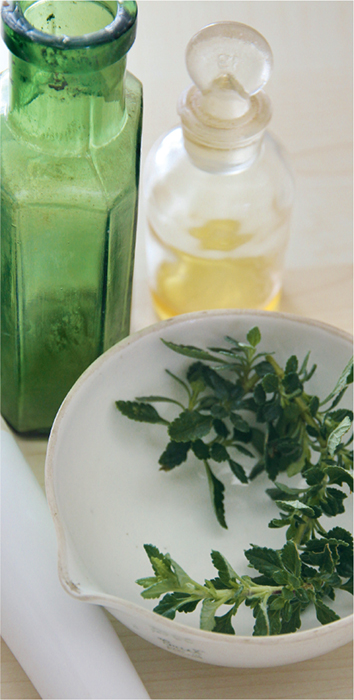
Wall germander, used medicinally, is a quick-acting herb.
The Holy Roman Emperor Charles V (1500–1558) was cured of debilitating gout by taking a little wall germander tea for 60 days and bathing in a steam bath with fresh flowering sprigs. His cure made the history books!
Walnut
Family Juglandaceae
Species: Juglans regia
Origin: Southeastern Europe, western Asia
Plant: Deciduous tree
Height: Up to 20 m
Soil: Deep, well-dug, richly composted soil
Exposure: Full sun
Propagation: Ripe nuts or cuttings
Uses: Culinary, medicinal
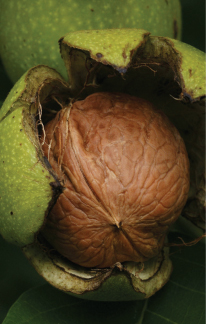
(c) Böhringer Friedrich. Licensed under CC BY-SA 2.5 via Wikimedia Commons
The walnut was in use as a medicine and traded for centuries before the time of Christ. In 100 bc it was imported into Italy, where it was cultivated as a medicine, and it reached the British Isles at the beginning of the 16th century. The beautiful hardwood was made into furniture for royalty.
Medicinally, walnut leaves and nuts became renowned as a treatment for insomnia, as a digestive, and to treat the brain. The nut resembles the shape of the brain and was used to help cure mental disorders; it became well known for this and thus found a place in the early pharmacopoeias.
CULTIVATION
Deep, rich, well-dug heavy soil and full sun are needed to produce a reliable crop of nuts. Prepare a 1 m × 1 m hole filled with rich compost dug into equal quantities of topsoil. Set a wide pipe into the hole at an angle so that water can reach the roots; insert a hose weekly. Make a wide ‘dam’ around the tree. A barrow-load of compost during winter will help to ensure a good crop of spring nuts. Male and female flowers appear at the same time in spring, and the fruit appears soon afterwards, often in clusters. Flood the dam around the tree with water once a week through this time. Give compost often.
PROPAGATION
Propagation is by taking cuttings and planting them in moist sand; you will need small, strong, leafy twigs of last year’s growth. Once the little cuttings begin to shoot, move them out into the warm sunshine for an hour or two each day, and keep them warm at night until they are sturdy. Plant them into big pots and allow them to establish well before planting out.
Cuttings root very slowly and often growers of walnuts will suggest grafting onto similar root stock. My grandmother grew walnut trees from the nuts and the trees thrived. Nurturing protection is needed.
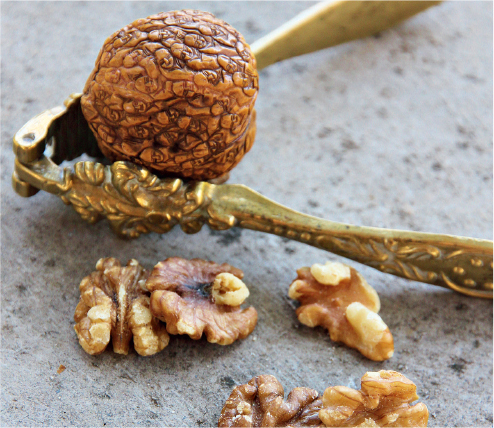
HARVESTING AND PROCESSING
As soon as the outer casings of the nuts split open, it is time to harvest. The kernels are known as ‘hu tao ren’ in China. Allow the nuts to dry for a week before cracking open and using. Shell off the outer casings, and store in a glass jar for medicinal use, finely chopped and dried. Reap the leaves throughout the spring, summer and autumn and dry some on brown paper in the shade for winter teas. The bark of the walnut is also used in China for medicines and hair dyes.
COMPANION PLANTING
The walnut likes to have bare soil around its roots; nothing thrives in its dense shade and it needs space as it can become a big tree. In walnut plantations, oats and barley are grown between the rows, and winter wheat where the winters are mild.
CULINARY USES
Walnut oil is wonderfully rich on salads. The chopped nuts are used in biscuits, rusks, ice-creams and fruit salads as a gourmet treat. Store the nuts in the fridge as they can go rancid quickly, and buy walnuts in their shells, as this lengthens their life. Walnut tea is an excellent base for cool drinks. Chopped walnuts blended with olive oil and basil leaves makes a flavour-filled pesto to serve with pasta.
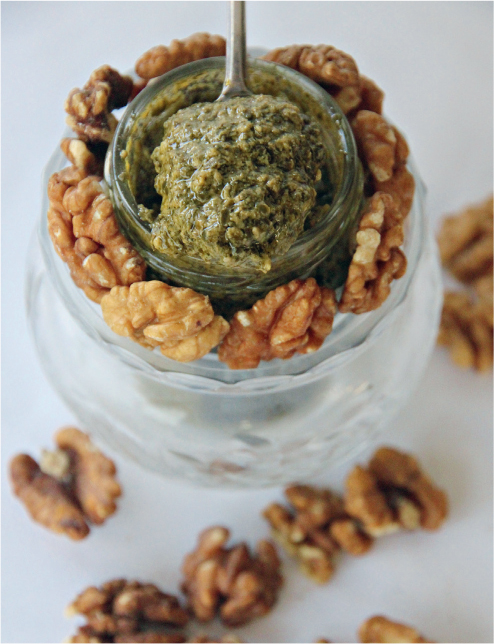
Walnut and basil pesto
MEDICINAL USES
Fresh walnut leaves have anti-inflammatory, anti-microbial and astringent properties. Walnut lotion was used through the centuries to treat eczema, weeping skin ailments, infected acne, severe rashes, and herpes. Use the cooled tea as a lotion, or apply with a spritz-spray. Use it as a rinse for hair loss; at the same time, take one cup of walnut leaf tea daily for 10 days. Give the remedy a break for four days and then continue. Walnut leaf tea is excellent for hair loss, eye ailments, menstrual problems, constipation, chest ailments, coughs and asthma. It helps to lower cholesterol, discourages internal parasites, and relieves bladder stones, urinary ailments, diarrhoea and anaemia. In China, it is respected as a tonic for the kidneys. A comforting walnut cream can be made for very dry skin conditions, rashes and weeping eczemas.
TO MAKE THE TEA: Boil two cups of fresh walnut leaves in a litre of water for 20 minutes. Simmer gently with the lid on before setting it aside to cool. Strain and cool, and use medicinally as a lotion; also take as a cup of hot tea with a slice of lemon and a touch of honey or fresh stevia leaves, once or twice a day as needed.

Welsh onion
Giant spring onion / Japanese leek
Family Amaryllidaceae
Species: Allium fistulosum
Origin: China
Plant: Perennial, clump-forming
Height: Up to 40 cm
Soil: Deeply dug, richly composted soil
Exposure: Full sun
Propagation: Division of the clump, seed
Uses: Culinary, medicinal
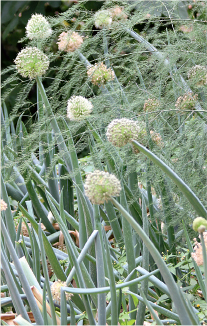
The name ‘welsh’ does not mean that the onion is indigenous to Wales; in this case, ‘welsh’ probably derives from the old German word ‘welsche’, meaning ‘foreign’, as the plant originated in Asia. Ancient herbals record it as a remedy for coughs, colds, bronchitis, productive mucus and pleurisy, with detailed drawings of its thick, hollow leaves and its big, ball-shaped white flowers.
The welsh onion became a sought-after trade in medieval times and it is thought that the Roman army had a lot to do with its spread and popularity as a food and medicine. It was made into delicious, healing broths for respiratory ailments, and used as a wound dressing, with the long, thick, hollow stems and leaves split, opened out and bound over wounds as a healing poultice. More recently, welsh onions were used by the ‘barefoot doctors’ in China and Japan. Overall, the onion family is one of the most valuable groups of plants, long recognised for its culinary and medicinal contribution. This is an exceptional plant for the home vegetable garden.
CULTIVATION
Prepare a deeply dug, richly composted bed in full sun, water it well and then plant out 4–5 little onions in clumps. Space the rows 30 cm apart and water twice weekly; more often in hot weather. Robust, fast and easy to grow, the welsh onion makes a juicy border, with frequent flowers that scatter tiny threads of little seedlings.
PROPAGATION
Only the fresh seed is viable, so watch the maturing heads and catch the ripening seed in a paper bag tied over the flower head. Quickly sow the tough little black seeds in compost-filled trays; if the trays are kept moist and protected, the rewards will be 100 per cent germination. To propagate by division, lift the clump in late winter and divide by putting two back-to-back forks into it. Gently lever the clump apart and plant the divisions out into their permanent positions.
HARVESTING AND PROCESSING
Pick as needed; always replant one or two onions every time you reap. Harvest the seeds and use as delicious sprouts.

Crackers with cream cheese and sliced welsh onion leaves
CULINARY USES
Sliced into thin rings, welsh onions make a fabulously tasty and unusual salad with thinly sliced cucumber, pineapple and celery. Dress the salad liberally with a black pepper, mustard, lemon juice, honey and olive oil dressing. Fennel seeds with crushed coriander can be added to the dressing too, for a full, rich taste.
For the lunch box, try thinly sliced fresh radish on a home-baked brown bread sandwich. Spread with cream cheese and thinly sliced welsh onion leaves, a squeeze of lemon juice, sea salt and freshly ground black pepper or red cayenne pepper as an immune-boosting health lunch.
Grow a row of welsh onions and try them sliced thinly into rings in soups, stews and stir-fries for an extra health boost and delicious flavour.
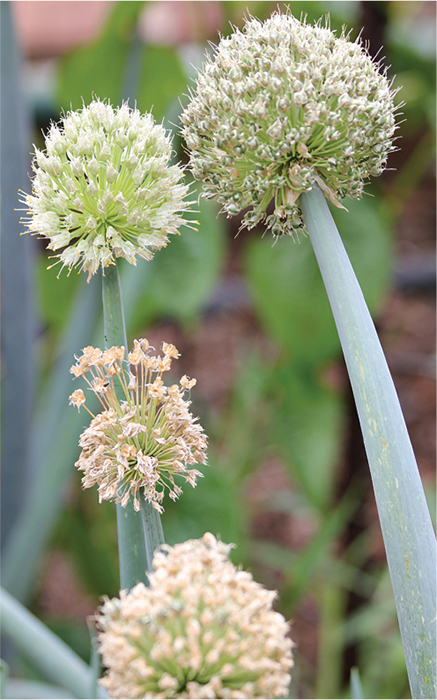
MEDICINAL USES
In past times, a simple chicken broth was often made for the family to ward off colds, to boost the immune system, and to clear the lungs with its expectorant, anti-spasmodic, antibiotic and diuretic effects. This broth is still considered to be the first line of defence. It is light and tasty and appeals even when one is feeling unwell.
SERVES 4–6

Welsh onions make a juicy border plant and an excellent companion to lettuces, radishes and beetroot.
Black aphids love the welsh onion in a hot humid summer, so splash with soapy water or make a spray of khakibos (Tagetes minuta) and marigolds (T. erecta). To make this natural insecticide, pour a bucket of boiling water over ¾ bucket fresh khakibos and marigold leaves and sprigs. Leave it to draw overnight; next morning, strain, then spritz-spray or splash over the onions. Do this 2–3 days running and the aphids will succumb.
Wild rose pelargonium
Family Geraniaceae
Species: Pelargonium capitatum
Origin: South Africa
Plant: Sprawling perennial
Height: Up to 70 cm
Soil: Any soil, unfussy
Exposure: Full sun, can take light shade
Propagation: Seeds, cuttings
Uses: Culinary, medicinal

This soft and velvety wildflower grows in the Cape and parts of KwaZulu-Natal. It is a beautiful, easy-to-grow perennial with exceptional uses. I have always taught that a plant that draws your attention is important to you as a medicine or health-inducing herb, and the wild rose pelargonium has truly claimed my attention during the last few years. I have been forced to restudy it and to experiment with its many virtues. It is one of my favourite ‘new herbs’ of the future for its soothing and calming influence.
CULTIVATION
Wild rose pelargonium comes up self-sown as a lush, mounded cushion in barren places, inviting you to stop, crush and smell it. Of all the exquisite pelargonium varieties, the wild rose is among the most prolific, and by far the easiest to grow.
PROPAGATION
Both seeds and cuttings are rewarding and very viable. The seeds spread easily. Cuttings can be rooted in moist sand, and like to be planted out in full sun and even light shade. I often cut the long stems in midsummer into 20 cm lengths at the nodes and press these into a tray of wet, rich soil, spaced 10 cm apart. I keep the tray protected and shaded, and get 100 per cent rooted plants.
HARVESTING AND PROCESSING
The flowers and leaves can be picked and used fresh year-round. Leafy sprigs are evergreen and thrive with pruning at any time except in winter. Dry the leaves and flowers on fine mesh frames; cover with brown paper or muslin to keep the leaves dust-free. This can be done at any time except during the coldest months.
CULINARY USES
Two or three leaves added to jellies, ice-creams, custards, stewed apples or pears give a delicious flavour. The leaves can also be added to drinks as a fragrant de-stressor.
SERVES 6–8
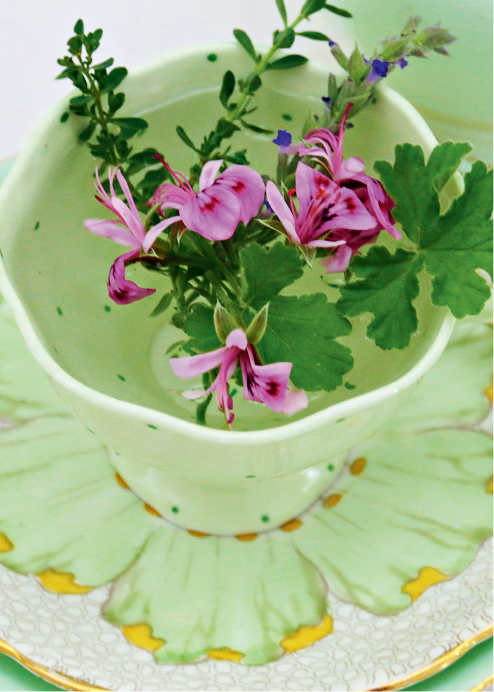
Wild rose pelargonium tea relieves nausea, stomach cramps and diarrhoea; fresh thyme sprigs can be added.
MEDICINAL USES
Long used as a medicinal herb tea, wild rose pelargonium is known for its ability to relieve nausea, vomiting, diarrhoea, gas and stomach cramps. The tea is a favourite medication for kidney and bladder ailments, and was made by the people of the Cape for centuries as a treatment for all the above conditions. Children respond quickly to a few teaspoons of the tea for cramp, colic, flatulence and burping, and in adults it also relieves sour belching, indigestion and heartburn. I have added a cupful to the dogs’ drinking water when I have seen them eating grass and heard tummy rumblings.
TO MAKE THE TEA: Pour a cup of boiling water over ¼ cup fresh wild rose pelargonium leaves and flower buds. Stir slowly, pressing the leaves and buds, then sweeten with honey and add a squeeze of lemon juice, and sip slowly.
This precious plant can be used as a poultice of warmed leaves over a sprain. It can also be used in the bath to clear radiation from the body by mixing four cups of non-iodated coarse sea salt with three cups of fresh wild rose pelargonium leaves. Tie a cupful of the mixture into a wet, warm facecloth and use as a body wash. Repeat as needed or save for the next bath. Tuck fresh leaves into a hot-water bottle cover (between the bottle and cover) and hold over a cramping muscle, tummy ache or a painful rheumatic area.
I learned from the field workers to rub the soft leaves over my hands to soothe callouses and blisters; this started me making healing oils and creams. The rose-scented pelargoniums (South Africa’s unique aromatic plants) provide favourite aromatherapy oils. Many French growers mix wild rose pelargonium (Pelargonium capitatum) with rose-scented geranium (P. graveolens) to make a superior oil to treat cramp, muscular spasms and digestive ailments.

Willow
Family Salicaceae
Species: Salix alba
Origin: Europe, North Africa, Central Asia
Plant: Tree
Height: Up to 25 m
Soil: Deep, moist, rich river banks
Exposure: Full sun
Propagation: Cuttings
Uses: Medicinal
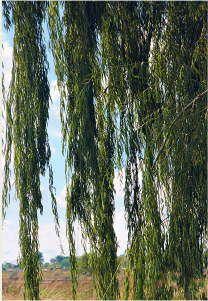
Few people are aware that aspirin comes from willow bark, and that willow was used traditionally as a pain reliever throughout the world. The bark was stripped from the branches and used fresh in infusions. It contains salicin, an anti-inflammatory agent, making willow a wonder tree for humankind, and an easy herb to use for pain relief. Many ways of taking willow are recorded, from wine to powders, infusions, syrups, fluid extractions, teas, macerations, and today even capsule form. However, it needs to be used with caution and always under a doctor’s guidance.
In the past, a wreath of green willow was tied around the head to relieve headaches, but interestingly, also to ease mourning and a broken heart. Because the willow tree seemed to symbolise sadness, with its branches bowed over the water, it was used as a remedy for grief. Old texts prescribe willow bark tea in cases of grief, loneliness and heartache. At one time, baskets made from willow were used to store the possessions of those who had left home, died, or gone to war, to ease the pain of loss.
Willow has a rich history in folklore and botanical medicine. It is said that gypsies once slept under willows to ease both pain and heartache, and to this day the scent and softness of the willow tree reminds us of its magical history and folklore.
CULTIVATION
Plant cuttings in full sun near a water source such as a dam or river, in rich soil (the generic name Salix derives from the Celtic ‘sal-lis’, meaning ‘near water’). Willow has separate male and female trees; catkins are larger on the male trees, and the female catkins produce nectar. The tree is fast-growing, easy to cultivate and attracts many types of insects, including bees. The ‘weeping willow’ commonly found near rivers in South Africa has the same uses as Salix alba (the white willow), and most of the Salicaceae family are interchangeable.
PROPAGATION
Cuttings of willow branches or twigs 50 cm long root easily in deep bags of wet sand, or if planted in late winter on a moist river bank or into a large pot of moist sand. Keep the pot protected and moist. Move it into the sun as the plant matures. The cutting will thrive if the roots are in continuous moisture and the plant is in full sun.

A willow hat wreath will keep you cool in summer; the wreath can also be worn around the head for headaches; and a nineteenth-century song (below is a verse) celebrates the willow as a panacea for grief.
All around my hat,
I will wear the green willow
All around my hat,
For a twelvemonth and a day
And if anyone should ask me the reason why I’m wearing it,
It’s all for my true love,
Who is far, far away.
HARVESTING AND PROCESSING
Leaves should be picked and used fresh, or dried in the shade and stored in a large screw-top jar for later use. Bark should be peeled off the branch or twigs while fresh, cut into pieces, and dried and stored in a separate jar. Both the leaves and the bark contain salicin and are used to make pain-relieving teas and bath infusions. Harvest enough when you get the chance.

Willow sticks, trimmed to make teas for pain; willow is used as a natural form of asprin.
MEDICINAL USES
A tea made from willow bark and leaves will help to ease headaches, neuralgia, fevers and inflammation (and heartache). Folklore around the willow abounds and has merged well with the findings of modern medical science. Willow bark tea was also used to treat feverish illnesses such as malaria, scarlet fever and chicken pox, as it reduces inflammation and discomfort. The tea relieves gout, rheumatism, the debilitating aches of auto-immune diseases, diarrhoea, dysentery, colic pains and general raised temperature and distress.
TO MAKE THE TEA: Pour a cup of boiling water over ¼ cup bark from the branches and six leaves. Stir and crush with a spoon for five minutes, strain, and sip slowly. In ancient times, nectar from the female catkins was added to sweeten the tea.
To make a pain-relieving infusion for the bath, boil fresh leaves, catkins and twigs in a large saucepan of water (enough to cover the willow fully), and simmer for 30 minutes. Keep the lid on the saucepan. Allow the infusion to cool a little and then pour the hot brew into the bath through a strainer, and dilute with just enough cold water to make the bath comfortable, but still hot enough to soothe the pain. Drink a cup of willow tea while soaking, then towel dry, keep warm and covered, and take a nap. You will wake up eased and relieved. I have found this treatment to be amazing and unfailing.
It was once thought that sitting in chairs made from willow wood would ease rheumatic pain, and pillows stuffed with willow leaves were used to relieve aching muscles. Another popular old remedy was to warm soft willow stems and leaves in hot water and wrap them around the aching legs and feet of elderly arthritic patients.
My grandmother made an effective treatment for corns by steeping fresh willow bark in brown grape vinegar for 14 days. Cotton-wool pads were then soaked in the willow lotion and taped around the toes each night until the corns dropped off!